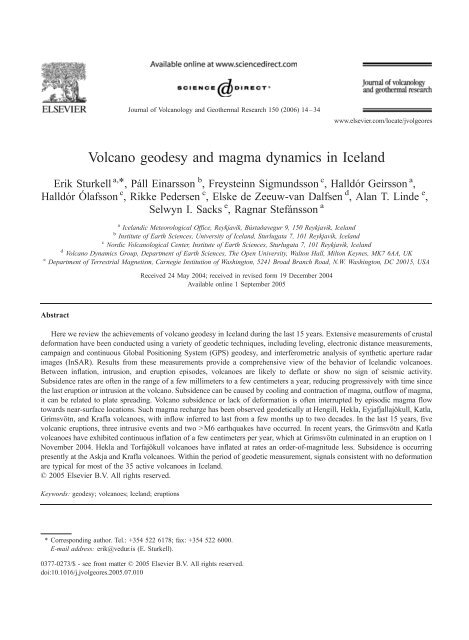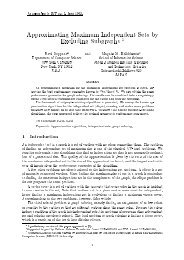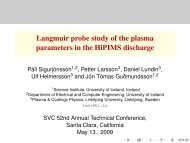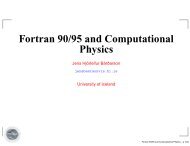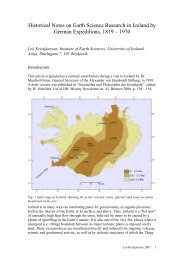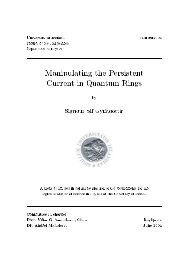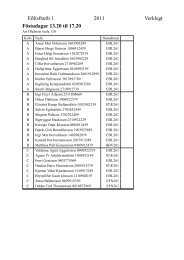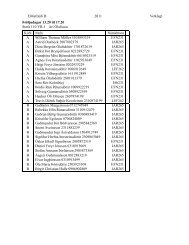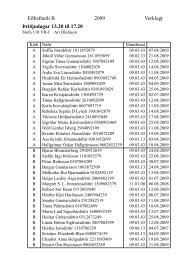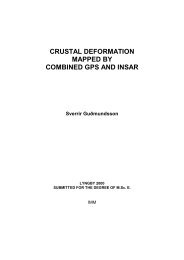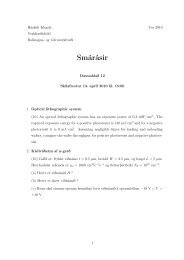Volcano geodesy and magma dynamics in Iceland - Acri-ST
Volcano geodesy and magma dynamics in Iceland - Acri-ST
Volcano geodesy and magma dynamics in Iceland - Acri-ST
Create successful ePaper yourself
Turn your PDF publications into a flip-book with our unique Google optimized e-Paper software.
Journal of <strong>Volcano</strong>logy <strong>and</strong> Geothermal Research 150 (2006) 14–34www.elsevier.com/locate/jvolgeores<strong>Volcano</strong> <strong>geodesy</strong> <strong>and</strong> <strong>magma</strong> <strong>dynamics</strong> <strong>in</strong> Icel<strong>and</strong>Erik Sturkell a, *,Páll E<strong>in</strong>arsson b , Freyste<strong>in</strong>n Sigmundsson c , Halldór Geirsson a ,Halldór Ólafsson c , Rikke Pedersen c , Elske de Zeeuw-van Dalfsen d , Alan T. L<strong>in</strong>de e ,Selwyn I. Sacks e , Ragnar Stefánsson aa Icel<strong>and</strong>ic Meteorological Office, Reykjavík, Bústaðavegur 9, 150 Reykjavík, Icel<strong>and</strong>b Institute of Earth Sciences, University of Icel<strong>and</strong>, Sturlugata 7, 101 Reykjavík, Icel<strong>and</strong>c Nordic <strong>Volcano</strong>logical Center, Institute of Earth Sciences, Sturlugata 7, 101 Reykjavík, Icel<strong>and</strong>d <strong>Volcano</strong> Dynamics Group, Department of Earth Sciences, The Open University, Walton Hall, Milton Keynes, MK7 6AA, UKe Department of Terrestrial Magnetism, Carnegie Institution of Wash<strong>in</strong>gton, 5241 Broad Branch Road, N.W. Wash<strong>in</strong>gton, DC 20015, USAReceived 24 May 2004; received <strong>in</strong> revised form 19 December 2004Available onl<strong>in</strong>e 1 September 2005AbstractHere we review the achievements of volcano <strong>geodesy</strong> <strong>in</strong> Icel<strong>and</strong> dur<strong>in</strong>g the last 15 years. Extensive measurements of crustaldeformation have been conducted us<strong>in</strong>g a variety of geodetic techniques, <strong>in</strong>clud<strong>in</strong>g level<strong>in</strong>g, electronic distance measurements,campaign <strong>and</strong> cont<strong>in</strong>uous Global Position<strong>in</strong>g System (GPS) <strong>geodesy</strong>, <strong>and</strong> <strong>in</strong>terferometric analysis of synthetic aperture radarimages (InSAR). Results from these measurements provide a comprehensive view of the behavior of Icel<strong>and</strong>ic volcanoes.Between <strong>in</strong>flation, <strong>in</strong>trusion, <strong>and</strong> eruption episodes, volcanoes are likely to deflate or show no sign of seismic activity.Subsidence rates are often <strong>in</strong> the range of a few millimeters to a few centimeters a year, reduc<strong>in</strong>g progressively with time s<strong>in</strong>cethe last eruption or <strong>in</strong>trusion at the volcano. Subsidence can be caused by cool<strong>in</strong>g <strong>and</strong> contraction of <strong>magma</strong>, outflow of <strong>magma</strong>,it can be related to plate spread<strong>in</strong>g. <strong>Volcano</strong> subsidence or lack of deformation is often <strong>in</strong>terrupted by episodic <strong>magma</strong> flowtowards near-surface locations. Such <strong>magma</strong> recharge has been observed geodetically at Hengill, Hekla, Eyjafjallajökull, Katla,Grímsvötn, <strong>and</strong> Krafla volcanoes, with <strong>in</strong>flow <strong>in</strong>ferred to last from a few months up to two decades. In the last 15 years, fivevolcanic eruptions, three <strong>in</strong>trusive events <strong>and</strong> two NM6 earthquakes have occurred. In recent years, the Grímsvötn <strong>and</strong> Katlavolcanoes have exhibited cont<strong>in</strong>uous <strong>in</strong>flation of a few centimeters per year, which at Grímsvötn culm<strong>in</strong>ated <strong>in</strong> an eruption on 1November 2004. Hekla <strong>and</strong> Torfajökull volcanoes have <strong>in</strong>flated at rates an order-of-magnitude less. Subsidence is occurr<strong>in</strong>gpresently at the Askja <strong>and</strong> Krafla volcanoes. With<strong>in</strong> the period of geodetic measurement, signals consistent with no deformationare typical for most of the 35 active volcanoes <strong>in</strong> Icel<strong>and</strong>.D 2005 Elsevier B.V. All rights reserved.Keywords: <strong>geodesy</strong>; volcanoes; Icel<strong>and</strong>; eruptions* Correspond<strong>in</strong>g author. Tel.: +354 522 6178; fax: +354 522 6000.E-mail address: erik@vedur.is (E. Sturkell).0377-0273/$ - see front matter D 2005 Elsevier B.V. All rights reserved.doi:10.1016/j.jvolgeores.2005.07.010
16E. Sturkell et al. / Journal of <strong>Volcano</strong>logy <strong>and</strong> Geothermal Research 150 (2006) 14–3424ºW 22ºW 20ºW 18ºW16ºW 14ºW66ºNKrafla65ºN9.7 mm/yrAskjaNorth AmericanPlate64ºN100 kmHHeklaTEGjálpKatlaBGVatnajökullBEGHT9.7 mm/yrEurasian PlateBár arbungaEyjafjallajökullGrímsvötnHengill/Hrómundart<strong>in</strong>durTorfajökullFig. 2. The different volcanoes <strong>in</strong> Icel<strong>and</strong> addressed <strong>in</strong> the text are shown <strong>and</strong> all of the active volcanic system are outl<strong>in</strong>ed <strong>in</strong> black.jökull, Katla <strong>and</strong> Hrómundart<strong>in</strong>dur have shown measurabledeformation <strong>in</strong>terpreted as the result of <strong>magma</strong>movements at depth. Eyste<strong>in</strong>n Tryggvason <strong>in</strong>itiatedseveral important time series <strong>in</strong> the mid-late sixtiesthat are still cont<strong>in</strong>ued today. The aim of this paper isto provide a summary of recent deformation result.We will address the volcanic systems <strong>and</strong> eruptionsthat are currently studied by geodetic measurementsof crustal deformation, i.e., Hengill/ Hrómundart<strong>in</strong>dur,Hekla, Eyjafjallajökull, Katla, Torfajökull, Grímsvötn,Askja, Krafla, <strong>and</strong> Gjálp.2. Geodetic techniques2.1. Early techniquesThe first geodetic project specifically aimed at monitor<strong>in</strong>gof a volcano <strong>in</strong> Icel<strong>and</strong> was the establishment ofa level<strong>in</strong>g l<strong>in</strong>e at Askja <strong>in</strong> 1966 (Tryggvason, 1989).This technique was subsequently applied to severalvolcanoes, <strong>in</strong>clud<strong>in</strong>g Surtsey, Hekla, Katla, Hengill,<strong>and</strong> Krafla. A related technique, optical tilt measurements(or bdry tiltQ), has also been widely applied atsome of these volcanoes. Eyste<strong>in</strong>n Tryggvason<strong>in</strong>stalled benchmarks around several lakes <strong>in</strong> Icel<strong>and</strong><strong>and</strong> utilized lake surfaces as tiltmeters (Tryggvason,1987). By the time of the Hekla 1970 <strong>and</strong> 1980–81eruptions, electronic distance measur<strong>in</strong>g (EDM) <strong>in</strong>strumentswere available (e.g., Decker et al., 1971;Kjartansson <strong>and</strong> Grönvold, 1983). EDM was alsoused extensively dur<strong>in</strong>g the volcano–tectonic eventsat Krafla <strong>in</strong> 1975–1984. Electronic tiltmeters weredesigned <strong>and</strong> applied for cont<strong>in</strong>uous monitor<strong>in</strong>g oftilt changes (e.g., Tryggvason, 1986). Extensometerswere <strong>in</strong>stalled across fractures to monitor changes <strong>in</strong>their width (Hauksson, 1983). Additionally, gravitymeasurements were applied to monitor the extensivevertical movements at Krafla (Johnsen et al., 1980).A network of volumetric stra<strong>in</strong>meters (Sacks et al.,1971) was <strong>in</strong>stalled <strong>in</strong> the South Icel<strong>and</strong> SeismicZone <strong>in</strong> the late seventies for cont<strong>in</strong>uous monitor<strong>in</strong>gof stra<strong>in</strong> load<strong>in</strong>g of the seismic zone. These <strong>in</strong>strumentshave shown stra<strong>in</strong> changes associated with therecent Hekla eruptions <strong>and</strong> have proven to be veryimportant <strong>in</strong> the monitor<strong>in</strong>g of Hekla (e.g., L<strong>in</strong>de etal., 1993).Advances <strong>in</strong> geodetic methods <strong>in</strong> the last decadehave brought new techniques that turn out to be veryvaluable <strong>in</strong> volcano monitor<strong>in</strong>g <strong>in</strong> Icel<strong>and</strong>. These<strong>in</strong>clude GPS-<strong>geodesy</strong> (both campaign <strong>and</strong> cont<strong>in</strong>uousGPS), InSAR, <strong>and</strong> micro-gravity measurements.Older techniques, such as optical tilt <strong>and</strong> level<strong>in</strong>g,are also still widely applied.
E. Sturkell et al. / Journal of <strong>Volcano</strong>logy <strong>and</strong> Geothermal Research 150 (2006) 14–34 172.2. GPS (campaign)The first GPS-campaign <strong>in</strong> Icel<strong>and</strong> was performed<strong>in</strong> 1986 when a regional network cover<strong>in</strong>g most ofIcel<strong>and</strong> was established. The purpose of the networkwas ma<strong>in</strong>ly to monitor plate spread<strong>in</strong>g (Foulger et al.,1987). The first GPS survey of an <strong>in</strong>dividual volcano<strong>in</strong> Icel<strong>and</strong> was conducted <strong>in</strong> 1991 around Hekla (Sigmundssonet al., 1992). The GPS network has s<strong>in</strong>cebeen exp<strong>and</strong>ed to cover most volcanoes show<strong>in</strong>gsigns of activity.has been ga<strong>in</strong><strong>in</strong>g popularity s<strong>in</strong>ce the early 1990s(e.g., Massonnet <strong>and</strong> Feigl, 1998; Dzuris<strong>in</strong>, 2003).Interferometric process<strong>in</strong>g of two SAR imagesacquired from about the same orbital position but atseparate times may reveal a phase <strong>in</strong>terference patterncaused by a change <strong>in</strong> distance from ground to satellitewith<strong>in</strong> this time span (Fig. 3). A fr<strong>in</strong>ge patternemerges with each fr<strong>in</strong>ge correspond<strong>in</strong>g to a phaseA2.3. CGPS (Cont<strong>in</strong>uous GPS)Crustal deformation <strong>in</strong> near real-time is currentlyrecorded at 17 CGPS sites <strong>in</strong> order to monitor platespread<strong>in</strong>g, volcanic deformation <strong>and</strong> co-seismic displacements.The stations are concentrated around theplate boundary (Fig. 1). The CGPS data are automaticallydownloaded <strong>and</strong> processed on a daily basisus<strong>in</strong>g predicted satellite orbits <strong>and</strong> reprocessed withf<strong>in</strong>al orbits when they become available. The resultsare available on the IMO website for public view<strong>in</strong>g(http://www.vedur.is/ja). The time series from theCGPS stations are mostly dom<strong>in</strong>ated by plate spread<strong>in</strong>g,but deviations are observed at stations close to<strong>in</strong>dividual volcanoes (Geirsson, 2003). The CGPSstations give excellent time resolution of volcanicactivity, but due to high <strong>in</strong>stallation <strong>and</strong> operat<strong>in</strong>gcosts their spatial coverage is necessarily much sparserthan that provided by campaign GPS.5 kmB2.4. InSARApplication of <strong>in</strong>terferometric synthetic apertureradar images (InSAR) <strong>in</strong> crustal deformation studiesCFig. 3. A) InSAR image show<strong>in</strong>g surface uplift at the Eyjafjallajökullvolcano modified from Pedersen <strong>and</strong> Sigmundsson (2004). The<strong>in</strong>terferogram covers the time period 6 Sep. 1992 to 15 Aug. 1995<strong>and</strong> shows deformational fr<strong>in</strong>ges due to an <strong>in</strong>trusion event <strong>in</strong> 1994.One full color fr<strong>in</strong>ge corresponds to 2.8 cm of range change.Location of the study area is shown <strong>in</strong> Fig. 1. The outl<strong>in</strong>e of theEyjafjallajökull ice cap is given <strong>in</strong> black. The <strong>in</strong>terferogram isoverla<strong>in</strong> on a SAR amplitude image. B) The fr<strong>in</strong>ge pattern that ispredicted by a sill with variable open<strong>in</strong>g up to 0.36 m. A green stardenotes the alternative optimal Mogi source. Grey circles shows thebest located earthquakes from the swarm <strong>in</strong> 1994. C) Residual<strong>in</strong>terferogram, the difference between (A) <strong>and</strong> (B).
18E. Sturkell et al. / Journal of <strong>Volcano</strong>logy <strong>and</strong> Geothermal Research 150 (2006) 14–34difference of 2k which for the ERS satellites is 2.8cm. In Icel<strong>and</strong>, utilization of the technique has yieldedgood results (e.g., Vadon <strong>and</strong> Sigmundsson, 1997;Pedersen et al., 2003; de Zeeuw-van Dalfsen et al.,2004a). Comb<strong>in</strong><strong>in</strong>g three component GPS data withthe spatial coverage of InSAR data is currently themost powerful tool <strong>in</strong> volcano <strong>geodesy</strong>.2.5. Micro-gravityMicro-gravity techniques can be used to identifysub-surface mass redistributions related to volcanicactivity (Rymer, 1996). To be able to <strong>in</strong>terpret theresults unambiguously, it is essential that heightchanges are known at least with centimeter precision.The comb<strong>in</strong>ation of micro-gravity with geodetic dataforms a powerful tool to get better <strong>in</strong>sight <strong>in</strong>to volcanicsystems, rather than with any of the two techniquesalone. Repeated micro-gravity measurementshave been conducted with<strong>in</strong> the Askja volcano s<strong>in</strong>ce1988 (Rymer <strong>and</strong> Tryggvason, 1993; de Zeeuw-vanDalfsen et al., 2004b) <strong>and</strong> at Krafla volcano s<strong>in</strong>ce1975 (Johnsen et al., 1980; Rymer et al., 1998). Theresult<strong>in</strong>g data are among the most extensive microgravitydata sets <strong>in</strong> the world.3. Recent <strong>magma</strong>tic activity <strong>and</strong> geodeticobservationsS<strong>in</strong>ce the early n<strong>in</strong>eties, <strong>in</strong>stallation of an extensiveGPS network <strong>and</strong> <strong>in</strong>troduction of InSAR technology,have improved the ability to measure <strong>magma</strong> movements.More data has resulted <strong>in</strong> a more completepicture of volcano deformation <strong>in</strong> the active volcaniczones. Three volcanoes <strong>in</strong> Icel<strong>and</strong> dom<strong>in</strong>ate the eruptionstatistics <strong>and</strong> are the most active: Grímsvötn,Hekla <strong>and</strong> Katla (Fig. 2). S<strong>in</strong>ce 1990 there havebeen measurable movements at n<strong>in</strong>e volcanoes, 5confirmed eruptions, 3 <strong>in</strong>flation episodes, <strong>and</strong> severalevents suspected to be small subglacial eruptions.Three volcanoes are currently <strong>in</strong>flat<strong>in</strong>g, two of themat a rate of several centimeters a year.3.1. KraflaThe episode of <strong>magma</strong>tic <strong>and</strong> rift<strong>in</strong>g activity with<strong>in</strong>the Krafla volcanic system from 1974 to 1989 offereda multitude of opportunities to study crustal deformationassociated with <strong>magma</strong> movements. Located <strong>in</strong>the Northern Volcanic Zone, the Krafla system consistsof a central volcano with a caldera <strong>and</strong> a transect<strong>in</strong>gfissure swarm. High-temperature geothermalsystems are located with<strong>in</strong> the Krafla caldera, provid<strong>in</strong>genergy for the Krafla power plant. The 1974–1989rift<strong>in</strong>g activity affected a 100 km long section of theplate boundary (see e.g., Björnsson et al., 1977;E<strong>in</strong>arsson, 1991a; Tryggvason, 1995). Dur<strong>in</strong>g mostof this time <strong>magma</strong> <strong>in</strong>flow <strong>in</strong>to a shallow-level<strong>magma</strong> chamber beneath the caldera caused <strong>in</strong>flationof the caldera region. This <strong>in</strong>flation was <strong>in</strong>terrupted bysudden deflation events when the walls of the chamberwere breached <strong>and</strong> dykes were <strong>in</strong>jected <strong>in</strong>to theadjacent fissure swarm (Tryggvason, 1980; E<strong>in</strong>arsson<strong>and</strong> Br<strong>and</strong>sdóttir, 1980; Br<strong>and</strong>sdóttir <strong>and</strong> E<strong>in</strong>arsson,1979). Large scale rift<strong>in</strong>g occurred with<strong>in</strong> the fissureswarm dur<strong>in</strong>g these events. In n<strong>in</strong>e out of twenty casesthe dyke reached the surface <strong>and</strong> produced basalticfissure eruptions. Extensive geodetic measurementshave been conducted at Krafla, utiliz<strong>in</strong>g most availablemethods.The Krafla power plant was under constructionwhen the activity started <strong>in</strong> 1974. The foundation ofthe new power station build<strong>in</strong>g had been surveyed byprecise level<strong>in</strong>g <strong>in</strong> order to monitor its settl<strong>in</strong>g dur<strong>in</strong>gconstruction. The Krafla station turned out to be ideallylocated for monitor<strong>in</strong>g of tilt variations associatedwith the Krafla <strong>magma</strong> chamber. A water tube tiltmeterwas <strong>in</strong>stalled <strong>in</strong> the build<strong>in</strong>g <strong>in</strong> August 1976 <strong>and</strong> tworead<strong>in</strong>gs taken per day dur<strong>in</strong>g the next 11 years. This<strong>in</strong>strument was complemented by an electronic pendulumtiltmeter <strong>in</strong> August 1977 (Tryggvason, 1995).The tilt record <strong>in</strong> Fig. 4 is a composite of data obta<strong>in</strong>edby these three methods, i.e., level<strong>in</strong>g the foundation,water-tube tiltmeter <strong>and</strong> pendulum tiltmeter. The tiltparameter can be used as a proxy for the pressure <strong>in</strong> a<strong>magma</strong> chamber throughout a whole eruptive <strong>and</strong><strong>in</strong>trusive sequence. Level<strong>in</strong>g <strong>and</strong> tilt data from Krafla,both dur<strong>in</strong>g <strong>in</strong>flation <strong>and</strong> deflation periods, have beenused by several authors to derive the location <strong>and</strong>depth of a <strong>magma</strong> chamber (e.g., Björnsson et al.,1979; Tryggvason, 1980; Ewart <strong>and</strong> Voight, 1991).The pr<strong>in</strong>cipal conclusions of these studies are thatthe pressure source is located near the centre of thecaldera at slightly less than 3 km. Seismic studiesreveal a body of S-wave attenuation <strong>and</strong> low P-wave
E. Sturkell et al. / Journal of <strong>Volcano</strong>logy <strong>and</strong> Geothermal Research 150 (2006) 14–34 19µrad1000900 20 Dec. 758007006005004003002001000 1975 1976 1977 1978 1979 1980 1981 1982 1983 1984 1985 1986 1987 1988 198926 Sep. 7631 Oct. 7620 Jan. 7727 Apr. 778 Sep. 777 Jan. 7810 Jul. 7810 Nov. 7813 May 7916 Mar. 8010 July 8018 Oct. 8030 Jan. 8118 Nov. 81Fig. 4. Record of the one component water-tube tiltmeter at the Krafla power plant from August 1976 to January 1990. Data before August 1976orig<strong>in</strong>ate from level<strong>in</strong>g measurements of the power plant foundation. The water-tube tiltmeter was <strong>in</strong>stalled along the longer wall of the powerplant build<strong>in</strong>g that is orientated N138 E. The figure is modified after Tryggvason (1995). The stars mark eruptions.4 Sep. 84velocity with<strong>in</strong> the Krafla caldera (E<strong>in</strong>arsson, 1978;Br<strong>and</strong>sdóttir et al., 1997). Several l<strong>in</strong>es of evidencesuggest a deeper <strong>magma</strong> chamber at Krafla <strong>in</strong> additionto the one at 3 km depth. The cont<strong>in</strong>uous flow of<strong>magma</strong> towards the shallow chamber for over a decadedur<strong>in</strong>g the Krafla fires suggest <strong>magma</strong> was transportedfrom a localized reservoir or <strong>magma</strong> storage area at adeeper level <strong>in</strong> the crust or mantle. The location of it isuncerta<strong>in</strong>, but geodetic data shows that deformation onthe surface cannot fully be expla<strong>in</strong>ed by the 3 km deepchamber. The deformation field is wider thanexpected. Tryggvason (1986) <strong>in</strong>terpreted recordsfrom tiltmeters dur<strong>in</strong>g the September 1984 eruption<strong>in</strong> terms of three stacked <strong>magma</strong> chambers, but locationof the two deeper ones was not well resolved. Therole of two deeper sources, rather than one, <strong>in</strong> the 1984eruption, is also not certa<strong>in</strong>. Árnadóttir et al. (1998)<strong>in</strong>terpreted EDM <strong>and</strong> level<strong>in</strong>g data from the 1984eruption <strong>and</strong> confirmed that <strong>magma</strong> was dra<strong>in</strong>edfrom a deeper source <strong>in</strong> addition to the 3 km deepsource, to form a 1 m wide, 9 km long dyke, extend<strong>in</strong>gfrom the surface to about 7 km depth, <strong>and</strong> lava flowson the surface. The location of the deeper source wasconstra<strong>in</strong>ed to be deeper than 5 km, but narrow apertureof the geodetic network did not allow furtherresolution of its depth. The deformation associatedwith dyke <strong>in</strong>trusion events dur<strong>in</strong>g the Krafla fires isfor most events not well constra<strong>in</strong>ed. Level<strong>in</strong>g profilescross<strong>in</strong>g the fissure swarm <strong>in</strong> two places (Sigurdsson,1980; Kanngiesser, 1983) show how the flanks of thefissure swarm were uplifted while a central blockabove the dikes was downfaulted.The caldera region <strong>in</strong>flated after the last eruption(1984) until the pre-eruption level was approached.Then the <strong>in</strong>flation became <strong>in</strong>termittent. The last <strong>in</strong>flationperiod occurred <strong>in</strong> the summer of 1989. After thatthe caldera region has been slowly subsid<strong>in</strong>g, a fewcentimeters per year, as determ<strong>in</strong>ed by InSAR (Sigmundssonet al., 1997a) <strong>and</strong> a comb<strong>in</strong>ed geodetic <strong>and</strong>micro-gravity study (Rymer et al., 1998). In the postrift<strong>in</strong>gperiod, GPS revealed higher than averagespread<strong>in</strong>g rates. The post-rift<strong>in</strong>g deformation is fitby an elastic upper crust overly<strong>in</strong>g a visco-elasticlower crust <strong>and</strong> even weaker visco-elastic upper mantle(e.g., Foulger et al., 1992; Pollitz <strong>and</strong> Sacks, 1996).A recent InSAR study (de Zeeuw-van Dalfsen etal., 2004a) has revealed uplift over an about 50-kmwidearea at the Krafla volcanic system (8 cm from1993 to 1999), <strong>in</strong> addition to deformation caused bysubsidence above the shallow <strong>magma</strong> chamber, <strong>and</strong>effects of plate spread<strong>in</strong>g <strong>and</strong> post-rift<strong>in</strong>g adjustment(Fig. 5). The favored explanation of de Zeeuw-vanDalfsen et al. (2004a) for the widespread uplift is thatit results from <strong>magma</strong> accumulation at the crust–mantleboundary at 20 km depth, rather than be<strong>in</strong>g causedby post-rift<strong>in</strong>g adjustment.3.2. AskjaThe Askja volcano <strong>in</strong> the Northern Volcanic Zone(Fig. 1) has three overlapp<strong>in</strong>g <strong>and</strong> nested calderas.The ma<strong>in</strong> caldera, formed <strong>in</strong> the early Holocene, is 8km <strong>in</strong> diameter. An older caldera is discernable but ithas been filled by later lava flows. The most recentcaldera, Öskjuvatn, is 4.5 km <strong>in</strong> diameter <strong>and</strong> is filledby a lake. It was formed after the Pl<strong>in</strong>ian eruption of1875. The most recent eruption of Askja took place <strong>in</strong>1961 when a short E–W fissure opened up near theeastern caldera fault of the ma<strong>in</strong> caldera. A shortlevel<strong>in</strong>g l<strong>in</strong>e was <strong>in</strong>stalled <strong>in</strong> the ma<strong>in</strong> caldera <strong>in</strong>
20E. Sturkell et al. / Journal of <strong>Volcano</strong>logy <strong>and</strong> Geothermal Research 150 (2006) 14–34AH66NM1GM2KL10 km16WB 93-99curve with a decay constant of 39 years (Sturkell etal., submitted for publication). The geodetic data havebeen modeled <strong>and</strong> <strong>in</strong>terpreted <strong>in</strong> terms of a s<strong>in</strong>gleMogi-type pressure source (Mogi, 1958) locatedclose to the centre of the ma<strong>in</strong> Askja caldera (Tryggvason,1989; Rymer <strong>and</strong> Tryggvason, 1993; Sturkell<strong>and</strong> Sigmundsson, 2000). All these authors placed thepo<strong>in</strong>t source at 1.5 to 3.5 km depth. This modelA4291 km66NA406A404DYNG10 kmFig. 5. A) A InSAR amplitude image which <strong>in</strong>cludes the outl<strong>in</strong>e ofthe Krafla fissure swarm (dotted l<strong>in</strong>e) the Krafla central volcano(solid white l<strong>in</strong>e), the caldera (white dashed l<strong>in</strong>e) <strong>and</strong> the location oftwo model sources, a shallow <strong>magma</strong> chamber (M2) <strong>and</strong> about 20km deep source (M1). The location of the area is given <strong>in</strong> Fig. 1. B)An <strong>in</strong>terferogram spann<strong>in</strong>g the period from 1993 to 1999 show<strong>in</strong>gseveral features <strong>in</strong>clud<strong>in</strong>g subsidence above a shallow <strong>magma</strong>chamber (M2), <strong>in</strong>flation due to suggested deep <strong>magma</strong> accumulation(M1) <strong>and</strong> a N–S l<strong>in</strong>ear feature relat<strong>in</strong>g to plate spread<strong>in</strong>g.Modified from de Zeeuw-van Dalfsen et al. (2004a).65º10'N65º05'N í1966. The l<strong>in</strong>e was extended to 1.7 km length (Fig. 6)<strong>in</strong> 1968 <strong>and</strong> measured annually until 1972. Annualmeasurements were resumed <strong>in</strong> 1983 <strong>and</strong> the l<strong>in</strong>e wasalso extended. Because not all benchmarks are foundevery year due to snow cover, <strong>and</strong> because the entirel<strong>in</strong>e lies with<strong>in</strong> the deformation field of the volcano,benchmark 404 is arbitrarily set to zero. This po<strong>in</strong>t has<strong>in</strong> recent years been measured annually by GPS.To visualize the changes along this l<strong>in</strong>e we haveplotted the height difference between the end po<strong>in</strong>ts,A429 <strong>and</strong> A406, as a function of time (Fig. 7). StationA406 is 1 km closer to the caldera centre than A429.The data show that the volcano was <strong>in</strong>flat<strong>in</strong>g dur<strong>in</strong>g1970–1972. This had turned to deflation when measurementswere resumed <strong>in</strong> 1983, a trend that hascont<strong>in</strong>ued s<strong>in</strong>ce. The deflation follows an exponential65º00'Nkm0 5 10Öskjuvatn17º 00’W 16º 50’W 16º 40’W5 cmFig. 6. Horizontal GPS-displacements 1993–1998 <strong>in</strong> the Askjavolcano. The model with the two Mogi sources gave an estimateof the displacement of the reference station DYNG (white arrow).The horizontal displacements are adjusted for the displacement ofthe reference station. (Modified from Sturkell et al., submitted forpublication). Inset shows the location of level<strong>in</strong>g benchmarksdescribed <strong>in</strong> the text.
E. Sturkell et al. / Journal of <strong>Volcano</strong>logy <strong>and</strong> Geothermal Research 150 (2006) 14–34 21Cumulative vertical displacements [m]0.100.050.00-0.05-0.10-0.15-0.20(-(year - 1983) / 39.2)y = -49.8 + 45.7e1970 1975 1980 1985 1990 1995 2000YearFig. 7. Time series show<strong>in</strong>g cumulative vertical displacements atAskja between benchmark A406 <strong>and</strong> A429 s<strong>in</strong>ce 1968 (modifiedfrom Sturkell et al., submitted for publication). The time seriesprovides a measure of height change at the caldera centre, assum<strong>in</strong>g95% of the deformation (height differences between A406 <strong>and</strong>A429) is due to the shallow Mogi source (Sturkell et al., submittedfor publication). The decay start<strong>in</strong>g <strong>in</strong> 1983 is exponential. Trac<strong>in</strong>gthe subsidence curve back <strong>and</strong> extrapolat<strong>in</strong>g the <strong>in</strong>flation trend, thechange from <strong>in</strong>flation to deflation occurred <strong>in</strong> the middle of 1973.The Krafla rift<strong>in</strong>g episode started <strong>in</strong> December 1975.accounts for most of the observed displacements <strong>in</strong>the ma<strong>in</strong> caldera <strong>and</strong> its immediate vic<strong>in</strong>ity. At agreater distance, however, displacements observedwith GPS do not show the same good fit. A moreelaborate model is presented by Sturkell et al. (submittedfor publication) who <strong>in</strong>voke two Mogi sourcesto account for the far field displacements (Fig. 6). Theshallow source at 3 km depth <strong>and</strong> the deeper at 16 kmdepth. The shallow source contributes to an estimatedannual subsidence of 4.2 cm <strong>and</strong> the deeper sourceabout 1.0 cm. This model was also applied to theresults of a micro-gravity study for the period 1988–2003. A sub-surface mass decrease of 1.610 11 kg isderived (de Zeeuw-van Dalfsen et al., 2004b) <strong>in</strong>dicat<strong>in</strong>gthat <strong>magma</strong> dra<strong>in</strong>age is an important contributor tothe subsurface mass decrease <strong>and</strong> therefore to thesurface deflation. Interferometric analysis of syntheticaperture radar images from radar satellites (InSAR)have also been conducted (Pagli et al., 2003), <strong>and</strong>show clearly the ongo<strong>in</strong>g subsidence at Askja. TheInSAR data are be<strong>in</strong>g further analyzed. The geometryof the deeper pressure source has not been resolved.Sturkell et al. (submitted for publication) suggest thatthe onset of deflation at Askja <strong>in</strong> 1973 is causallyrelated to the beg<strong>in</strong>n<strong>in</strong>g of <strong>magma</strong> flow <strong>in</strong>to the Krafla<strong>magma</strong> chamber about 75 km to the north whichpreceded the rift<strong>in</strong>g episode of 1975–1984. We alsopo<strong>in</strong>t out that a series of large earthquakes began atthe Bárðarbunga volcano <strong>in</strong> 1974 that lasted until1996. The reverse fault<strong>in</strong>g mechanisms of theseevents were <strong>in</strong>terpreted by E<strong>in</strong>arsson (1991b) as theexpression of deflation of Bárðarbunga. The temporalcorrelation of deflation of Bárðarbunga <strong>and</strong> Askja <strong>and</strong>the beg<strong>in</strong>n<strong>in</strong>g of activity at Krafla suggests l<strong>in</strong>ksbetween the volcanoes, eventually by pressure connectionthrough the lower ductile crust <strong>in</strong> Icel<strong>and</strong>(E<strong>in</strong>arsson, 1991b).3.3. GrímsvötnThis highly active volcano most recently erupted <strong>in</strong>December 1998 <strong>and</strong> November 2004. Grímsvötn is asubglacial volcano, <strong>and</strong> deformation can only be measuredat a campaign GPS station located at the solenunatak on the caldera rim. Fig. 8 shows verticaldisplacement of the GPS po<strong>in</strong>t at Grímsvötn(GRIM). GPS measurements showed uplift beforethe 1998 eruption, followed by subsidence as thepressure dropped <strong>in</strong> the <strong>magma</strong> chamber. Measurementswere fitted to a Mogi model with the assumptionthat the source was located under the centre of theGrímsvötn caldera complex at a depth of at least 1.6km (Sturkell et al., 2003a). Inflation resumed atGrímsvötn follow<strong>in</strong>g the 1998 eruption <strong>and</strong> it wasassumed that the pressure of the Mogi-source wouldhave to surpass a critical level before a new eruptionwas to be expected. The critical level of the verticalcomponent of the GRIM station was suggested to beat least 0.15–0.20 m above the m<strong>in</strong>imum heightobta<strong>in</strong>ed immediately after the 1998 eruption (Sturkellet al., 2003a). A measurement <strong>in</strong> September 2004showed that the <strong>in</strong>flation had exceeded this level.Seismic activity <strong>in</strong>creased markedly <strong>in</strong> the latter halfof the year 2003 (Fig. 9) show<strong>in</strong>g that the stress <strong>in</strong> the<strong>magma</strong> chamber roof had <strong>in</strong>creased. Further <strong>in</strong>creaseof seismicity <strong>in</strong> late October <strong>and</strong> the onset of ajökulhlaup (a flood of melt water) from the Grímsvötncaldera lake on October 27 suggested that an eruptionmight be imm<strong>in</strong>ent, triggered by the pressure releaseof the flood. An eruption began <strong>in</strong> the even<strong>in</strong>g of
22E. Sturkell et al. / Journal of <strong>Volcano</strong>logy <strong>and</strong> Geothermal Research 150 (2006) 14–340.15vertical displacement [m]0.100.050.00-0.05GjalpGrímsvötnGrímsvötn-0.101995 2000 2005YearFig. 8. The vertical displacement of the GPS stat<strong>in</strong> at Grímsvötn (located at the top of the caldera rim) relative the reference po<strong>in</strong>t at Jökulheimar(JOKU <strong>in</strong> Fig. 1). The vertical displacement shows uplift prior to the 1998 eruption followed by subsidence as the pressure dropped <strong>in</strong> the<strong>magma</strong> chamber. Follow<strong>in</strong>g the 1998-eruption pressure <strong>in</strong>crease is observed, the 1997 <strong>in</strong>flation level was passed <strong>in</strong> 2003 <strong>and</strong> on 1 November2004 the volcano erupted. The tim<strong>in</strong>g of the eruptions at Gjálp <strong>in</strong> 1996 <strong>and</strong> Grímsvötn <strong>in</strong> 1998 <strong>and</strong> 2004 are shown by vertical bars. Modifiedfrom Sturkell et al. (2003a) with recent data.November 1 as <strong>in</strong>dicated by the appearance of lowfrequencyeruption tremor on nearby seismographs.The eruption onset was preceded by an <strong>in</strong>tense swarmof earthquakes. The geodetic <strong>and</strong> seismic precursorsto the eruption were recognized <strong>and</strong> formed the basisfor rather detailed eruption warn<strong>in</strong>gs issued to thecivil defense authorities, both <strong>in</strong> the long-term(months <strong>and</strong> year), <strong>in</strong>termediate-term (weeks <strong>and</strong>days) <strong>and</strong> short-term (hours) (Vogfjörd et al., 2005).3.4. GjálpIn the beg<strong>in</strong>n<strong>in</strong>g of October 1996, a sub-glacialeruption started on a fissure between the Bárðarbunga43start ofthe eruptionM l2102002 2003Year2004 2005Fig. 9. Magnitude of Grímsvötn earthquakes as a function of time, show<strong>in</strong>g <strong>in</strong>creased activity s<strong>in</strong>ce a seismic station was <strong>in</strong>stalled at Grímsvötn<strong>in</strong> 2002, until the 25 November 2004. The Grímsvötn volcano erupted <strong>in</strong> the even<strong>in</strong>g on 1 November 2004. All earthquakes larger thanmagnitude 1.0 that have been observed at four or more seismic stations are <strong>in</strong>cluded.
E. Sturkell et al. / Journal of <strong>Volcano</strong>logy <strong>and</strong> Geothermal Research 150 (2006) 14–34 23<strong>and</strong> Grímsvötn volcanoes (Fig. 1). This eruption fissurewas termed Gjálp (Gudmundsson et al., 1997).The eruption began on a 7 km long N–S fissure after36 h of <strong>in</strong>tense seismic activity at Bárðarbunga. Theseismicity propagated towards the eruption site suggest<strong>in</strong>gthat the eruption was fed from Bárðarbunga(E<strong>in</strong>arsson et al., 1997). The eruptive products werebasaltic <strong>and</strong>esites, different from recent eruptive productsof both Bárðarbunga <strong>and</strong> Grímsvötn. The similarityof the isotope characteristics with those ofGrímsvötn has led to suggestions that the eruptionwas fed by Grímsvötn volcano (Sigmarsson et al.,2000). The eruption lasted for thirteen days. In earlyNovember a jökulhlaup of approximately 3.8 km 3 ofmeltwater was released over Skeiðarárs<strong>and</strong>ur, shown<strong>in</strong> Fig. 1 (Gudmundsson et al., 1997).3.5. HeklaHekla volcano has had 18 summit eruptions <strong>and</strong>five <strong>in</strong> its direct surround<strong>in</strong>gs dur<strong>in</strong>g historic time,the last 1100 years. Precursory events have beendetected prior to recent eruptions. Generally, eruptionrelated earthquakes beg<strong>in</strong> less than two hours beforethe eruption starts (Soosalu et al., <strong>in</strong> press). Heklawas the first volcano <strong>in</strong> Icel<strong>and</strong> to be studied by alocal GPS-network. Measurements before <strong>and</strong> afterthe 1991 eruption revealed contraction towards thevolcano (Sigmundsson et al., 1992). The data suggesteda <strong>magma</strong> reservoir at 9 km depth, but uncerta<strong>in</strong>tieson this estimate were large because ofabsence of GPS stations close to the volcano (theclosest be<strong>in</strong>g at about 13 km distance). Measurementsprior to the 2000 eruption were conducted <strong>in</strong>1996. After the eruption measurements have beenconducted annually at selected po<strong>in</strong>ts. The 1996–2000 displacement reveal clearly deformation associatedwith the feeder dyke for the 2000 eruption(amount<strong>in</strong>g to several tens of cm). Further modell<strong>in</strong>gof these data are needed, <strong>in</strong> particular to constra<strong>in</strong>eventual <strong>in</strong>flation/deflation cycle at the volcano. GPSdata comb<strong>in</strong>ed with all other geodetic data fromHekla, <strong>in</strong>clud<strong>in</strong>g InSAR <strong>and</strong> optical level<strong>in</strong>g tilt hasthe potential to provide improved constra<strong>in</strong>ts on the<strong>magma</strong> plumb<strong>in</strong>g system under Hekla (Sigmundssonet al., 2001).Cont<strong>in</strong>uous monitor<strong>in</strong>g of crustal deformation <strong>in</strong>the South Icel<strong>and</strong> seismic zone (<strong>in</strong>clud<strong>in</strong>g Hekla) isdone by six cont<strong>in</strong>uously record<strong>in</strong>g borehole stra<strong>in</strong>metersoperated by the Icel<strong>and</strong>ic MeteorologicalOffice. The permanent stra<strong>in</strong>meters are located 15–45 km from Hekla <strong>and</strong> gave a clear stra<strong>in</strong> signalprior to the eruptions of 1991 <strong>and</strong> 2000 (Fig. 10).The closest volumetric stra<strong>in</strong> meter (15 km distance,at Búrfell <strong>in</strong> BUR <strong>in</strong> Fig. 10) detected compressiondue to dyke <strong>in</strong>jection 30 m<strong>in</strong> before <strong>magma</strong> reachedthe surface <strong>and</strong> the eruption started on February 26,2000 (Fig. 10). However, it had long been suspectedthat large stra<strong>in</strong> excursions at BUR were accompaniedby localized recovery, which may bias estimatesof <strong>magma</strong> source depth. This was confirmed bystra<strong>in</strong> records for the Mw 6.5 South Icel<strong>and</strong> earthquakes(the first occurr<strong>in</strong>g on 17 June <strong>and</strong> the secondon 21 June, 2000). The orig<strong>in</strong>al <strong>in</strong>terpretation ofthe stra<strong>in</strong> data at BUR associated with the 1991 <strong>and</strong>2000 eruptions of Hekla gave too shallow a sourcedepth. By consider<strong>in</strong>g the localized stra<strong>in</strong> recovery,Jónsson et al. (2003) prefer a deeper location thanthe 6.5 km suggested by L<strong>in</strong>de et al. (1993) for the<strong>magma</strong> source. The most recent estimate based onre-<strong>in</strong>terpretation of stra<strong>in</strong> data places the <strong>magma</strong>chamber at 11 km depth (Kristján Ágústsson pers.com. 2004). Despite these complications, the comb<strong>in</strong>ationof seismic <strong>and</strong> volumetric stra<strong>in</strong> monitor<strong>in</strong>ghas given strong evidence of <strong>magma</strong> propagationtowards the Earth’s surface <strong>and</strong> was used to issuea warn<strong>in</strong>g prior to the 2000 eruption.Seven short level<strong>in</strong>g arrays (bdry-tiltQ stations)are surveyed repeatedly around Hekla. The beststation, Næfurholt, is located 11 km west of thesummit, allow<strong>in</strong>g for easy monitor<strong>in</strong>g of E–W tilt.The tilt signal from the Næfurholt station is rathersmall but is still significant (Fig. 11). It suggests<strong>in</strong>flation beg<strong>in</strong>n<strong>in</strong>g directly after the 1991 <strong>and</strong> 2000eruptions. Eastward upward tilt generally <strong>in</strong>creaseswith time, as the volcano builds up pressure for thenext eruption, when a co-eruptive pressure decreaseoccurs. The most recent measurement (18 Nov.2004) of the tilt station at Næfurholt shows upwardtilt towards Hekla (Fig. 11). The east component<strong>in</strong>dicates that a pressure <strong>in</strong>crease under the volcanois of the same scale as prior to the 1991 <strong>and</strong> 2000eruptions. It should be po<strong>in</strong>ted out that one tiltstation gives only an <strong>in</strong>dication of possible <strong>magma</strong>accumulation under a volcano, <strong>and</strong> it should spursome additional measurements.
24E. Sturkell et al. / Journal of <strong>Volcano</strong>logy <strong>and</strong> Geothermal Research 150 (2006) 14–34200GEL100SAU<strong>ST</strong>OHELnanostra<strong>in</strong> (extension )0-100-200BURSKANANO<strong>ST</strong>RAIN1000800600400<strong>ST</strong>OSAUGELSKABUR200-3000 17 18 19 20 21 22Time (Days)26 27 28 29 1February 2000March 2000Fig. 10. Five days of data spann<strong>in</strong>g Hekla’s 2000 eruption from borehole stra<strong>in</strong>meters after removal of the effects of atmospheric pressurevariations <strong>and</strong> earth tides. Expansion is positive. The <strong>in</strong>set shows the stra<strong>in</strong>meter record for the 1991 Hekla eruption, which displays an almostidentical record. The squares show the stra<strong>in</strong> changes calculated from model<strong>in</strong>g the eruption <strong>in</strong> two stages. Stage one shows the deflation of adeep reservoir together with the dyke formation <strong>and</strong> stage two with cont<strong>in</strong>ued deflation of the deeper source. For location of the stra<strong>in</strong>meters seeFig. 1. (Modified from Agustsson et al., 2000).East tilt (µrad)50Eruption1985 1990 1995 2000 2005YearFig. 11. Data from the Næfurholt tilt station located 11 km directly west of the Hekla volcano. Its east–west tilt shows the radial tilt componentof deformation of the volcano. The observed tilt pattern repeats it self, suggest<strong>in</strong>g a cyclic pattern, with upward tilt <strong>in</strong> the direction of the Heklavolcano prior to the eruptions, followed by subsidence as <strong>magma</strong> dra<strong>in</strong>s from beneath the volcano. The most recent measurement (18 Nov 2004)<strong>in</strong>dicates that the east–west tilt is close to the critical value.Eruption
E. Sturkell et al. / Journal of <strong>Volcano</strong>logy <strong>and</strong> Geothermal Research 150 (2006) 14–34 253.6. KatlaKatla volcano has had 20 eruptions s<strong>in</strong>ce thesettlement period <strong>in</strong> 874 AD. (Larsen, 2000). Itscaldera, which is 600–700 m deep <strong>and</strong> encirclesan area of 100 km 2 (Björnsson et al., 2000) iscovered by the Mýrdalsjökull ice cap. The <strong>in</strong>itialphase of its eruption is phreato<strong>magma</strong>tic due to itsoccurrence at the base of the ice cap. Meltwaterfrom the eruption site is released as a jökulhlaup atthe ice marg<strong>in</strong>. Such floods are characterized by arapid rise to maximum discharge with<strong>in</strong> a period ofa few hours (Roberts et al., 2003). The most recentlarge eruption took place <strong>in</strong> 1918, generat<strong>in</strong>g amassive jökulhlaup. In 1955 a smaller jökulhlaupemerged from the eastern side of Mýrdalsjökull <strong>and</strong>two cauldrons were formed <strong>in</strong> the ice cap (Rist,1967). Guðmundsson et al. (2000) suggested thatthe jökulhlaup was caused by a small sub-glacialeruption that did not break the ice surface. In July1999 a sudden jökulhlaup occurred at the Sólheimajökulloutlet glacier (Fig. 12) on the south side ofthe Mýrdalsjökull ice cap (Sigurðsson et al., 2000).This was preceded by changes <strong>in</strong> earthquake activity<strong>and</strong> accompanied by tremor bursts (E<strong>in</strong>arsson,2000). A m<strong>in</strong>or sub-glacial eruption or a shallow<strong>in</strong>trusion could have triggered this jökulhlaup(Guðmundsson et al., 2000).The Katla area has shown persistent seismic activitys<strong>in</strong>ce the beg<strong>in</strong>n<strong>in</strong>g of seismograph observations<strong>in</strong> the first half of the last century. E<strong>in</strong>arsson <strong>and</strong>Br<strong>and</strong>sdóttir (2000) analyzed seismic data from theperiod 1978 to 1985, <strong>and</strong> found that the seismicitywas mostly located <strong>in</strong> two areas, one with<strong>in</strong> thecaldera <strong>and</strong> the other <strong>in</strong> the Goðabunga area to thewest of the caldera (Fig. 12). The seismicity has adist<strong>in</strong>ct seasonal pattern, particularly <strong>in</strong> the Godabungacluster (Fig. 13), with a large majority ofearthquakes occurr<strong>in</strong>g <strong>in</strong> the second half of theyear. This pattern has persisted for at least fourdecades. The autumn activity <strong>in</strong> 2001 was <strong>in</strong>tensebut with<strong>in</strong> normal limits. Seismic activity, however,did not stop <strong>in</strong> the w<strong>in</strong>ter of 2002 as it would have<strong>in</strong> a normal year <strong>and</strong> seismicity has been high evers<strong>in</strong>ce. In a recent study by Soosalu et al. (<strong>in</strong> press) alocal seismic net was set up on <strong>and</strong> around the63º45'NHAMRENTAGo a-bungaThe KatlacalderaAU<strong>ST</strong>63º30'N1 cmSólheimajökullSOHOHVOL10 km20ºW 19ºW19º15'WFig. 12. Observed horizontal <strong>and</strong> vertical displacements at Katla from June 2001 to March 2003, measured by GPS. The black arrows showhorizontal displacement, <strong>and</strong> the open arrows show vertical movements. All displacements are relative to the reference station at HAMR(Hamragarðar). This uplift <strong>and</strong> outward displacement from the centre of the caldera suggests <strong>magma</strong> <strong>in</strong>flow <strong>in</strong> a <strong>magma</strong> chamber, possiblelocated at 3–5 km depth. The vertical error is up to 7 mm.
26E. Sturkell et al. / Journal of <strong>Volcano</strong>logy <strong>and</strong> Geothermal Research 150 (2006) 14–346050M 0 *10E+13 [Nm]40302010Go abungaKatla caldera01997 1998 1999 2000 2001 2002 2003 2004 2005YearFig. 13. Accumulated seismic moment release from 1997 to 2004 <strong>in</strong> the Katla volcano. The area is divided <strong>in</strong>to two sub-areas; the Katla caldera<strong>and</strong> the area west of the caldera, the Goðabunga area. The division is drawn along a north–south l<strong>in</strong>e at 198 15V W (see Fig. 12). The moment–magnitude relation log M 0 =M l +10 from Slunga (1991) is used, where M 0 is the moment (<strong>in</strong> Nm) <strong>and</strong> M l the magnitude, for the 2775earthquakes with M 1 N1.7 recorded s<strong>in</strong>ce the beg<strong>in</strong>n<strong>in</strong>g of 1997 (2554 eq. <strong>in</strong> Goðabunga, 221 <strong>in</strong> the caldera). The earthquakes under Goðabungashow a clear seasonal correlation with a dist<strong>in</strong>ct activity dur<strong>in</strong>g the autumn. This pattern changed <strong>in</strong> 2002 to more cont<strong>in</strong>uous activity. Theearthquakes <strong>in</strong> the caldera have a swarm character, <strong>and</strong> the largest earthquakes occur there.glacier, with one station directly above the center ofthe activity <strong>in</strong> the Goðabunga area. This study gave amuch better depth constra<strong>in</strong>t for the hypocentrallocations <strong>and</strong> suggests that the Goðabunga clusteris an expression of an ascend<strong>in</strong>g, dome-shaped structurecreated by accumulation of viscous <strong>magma</strong> atshallow depth (cryptodome).The July 1999 event at Katla spurred both tilt <strong>and</strong>campaign GPS measurements. Tilt measurementsshowed no detectable displacements at the Katlavolcano, but the stations are located z12 km fromthe center of the Katla caldera. However, <strong>in</strong>flation ofthe neighbor<strong>in</strong>g volcano Eyjafjallajökull wasdetected (see the Eyjafjallajökull section). CampaignGPS measurements on nunataks <strong>in</strong> the ice cap, theENTA <strong>and</strong> AU<strong>ST</strong> sites (Fig. 12), have providedimportant results. The first campaign measurementsthat <strong>in</strong>clude the nunatak stations were performed <strong>in</strong>1993, <strong>and</strong> repeated for the first time <strong>in</strong> July 2000.The two stations displayed outward displacementfrom the center of the caldera, dur<strong>in</strong>g this period,<strong>in</strong>dicat<strong>in</strong>g that <strong>magma</strong> accumulation had started(Sturkell et al., 2003b). The nunatak sites havebeen visited annually s<strong>in</strong>ce year 2000, <strong>and</strong> recentlytwice a year. The GPS measurements for the period2001 to 2003 is shown <strong>in</strong> Fig. 12 <strong>and</strong> display uplift<strong>and</strong> outward horizontal displacement from the centreof the sub-glacial caldera. These displacements fitwell with a po<strong>in</strong>t source at 4.7 km depth with<strong>in</strong> thecaldera <strong>and</strong> give an uplift rate of about 2 cm/a s<strong>in</strong>ce2000 at the GPS po<strong>in</strong>t AU<strong>ST</strong> (Sturkell et al.,2003c).The Katla GPS-network is complemented by twocont<strong>in</strong>uous GPS-stations, (SOHO <strong>and</strong> HVOL), whichwere <strong>in</strong>stalled <strong>in</strong> the autumn of 1999, at the southernflank (Fig. 12). After consider<strong>in</strong>g expected platemovements, they display residual outward displacements(southward) from the volcano centre (Fig. 14).This southward displacement has been observed s<strong>in</strong>cethe year 2000. The southward displacement observedfrom the cont<strong>in</strong>uous stations is not uniform <strong>in</strong> time<strong>and</strong> shows periods with accelerated southward displacements.This suggests eventual annual component ofdeformation related to variable ice load<strong>in</strong>g. Altogether,the geodetic data suggest progressive caldera<strong>in</strong>flation over time. From 2000, the measured sub-
E. Sturkell et al. / Journal of <strong>Volcano</strong>logy <strong>and</strong> Geothermal Research 150 (2006) 14–34 27EA<strong>ST</strong> (mm)NORTH (mm)UP (mm)1009080706050403020100-10-203020100-10-20-30-40-50-60-70605040302010-10 0-20-30-40-50-60The Hekla eruptionThe June earthquakes2000 2001 2002 2003 2004 20052000 2001 2002 2003 2004 20052000 2001 2002 2003 2004 2005YearFig. 14. Time-series plot of the cont<strong>in</strong>uous GPS station SOHO, located at the southern edge of Mýrdalsjökull ice-cap cover<strong>in</strong>g the Katlavolcano, relative to REYK (the cont<strong>in</strong>uous GPS station <strong>in</strong> Reykjavík). Times of the Hekla eruption <strong>in</strong> February 2000 <strong>and</strong> the June 2000 southIcel<strong>and</strong> seismic zone earthquake sequence are noted with vertical l<strong>in</strong>es. For reference, the predicted movement of SOHO from the NUVEL1-Amodel (DeMets et al., 1994) is shown with solid l<strong>in</strong>es. Outliers have been removed <strong>and</strong> error bars are at the 2 r level.surface volume <strong>in</strong>crease is ~0.011 km 3 . In comparison,the eruptive volume of the 1918 Katla eruptionwas of the order of 1 km 3 . In summary there areseismic, geodetic <strong>and</strong> geothermal <strong>in</strong>dications thatKatla has entered an agitated state that most likelybegan <strong>in</strong> 1999. The most recent GPS measurements(from March 2003 to January 2004) confirm that theunrest at Katla cont<strong>in</strong>ues with the same rate.
28E. Sturkell et al. / Journal of <strong>Volcano</strong>logy <strong>and</strong> Geothermal Research 150 (2006) 14–343.7. EyjafjallajökullThe volcano Eyjafjallajökull has an ice cap withthe same name. No volcanic activity is known fromthe time of settlement (874 AD) until 1612. Annals forthat year mention an eruption <strong>in</strong> Eyjafjallajökull orKatla, but it is not clear whether one volcano or bothwere active. A small eruption occurred <strong>in</strong> 1821–1823(Larsen, 1999). Prior to 1991, the Eyjafjallajökullvolcano showed <strong>in</strong>significant seismic activity for atleast three decades (time of seismic coverage). An<strong>in</strong>crease <strong>in</strong> activity started near the end of 1991 <strong>and</strong>peaked with an earthquake swarm <strong>in</strong> 1994. Unrestcont<strong>in</strong>ued, <strong>and</strong> a second earthquake swarm occurred<strong>in</strong> 1999. The seismic activity that started <strong>in</strong> the earlyn<strong>in</strong>eties cont<strong>in</strong>ues with a higher background level thanbefore 1991 (Fig. 15).The 1994 <strong>and</strong> 1999 seismic episodes at Eyjafjallajökullwere associated with significant <strong>in</strong>flation of thevolcano <strong>in</strong>dicat<strong>in</strong>g <strong>in</strong>trusions under its southern flank.The tim<strong>in</strong>g of the deformation is bracketed by tilt <strong>and</strong>GPS measurements (Sturkell et al., 2003b) for boththe <strong>in</strong>trusive events (Fig. 15). The deformation datafrom 1999 are modelled by a po<strong>in</strong>t pressure source at3.5 km depth beneath the flank of the volcano, about 4km south of the summit crater. Maximum uplift of themodel is 0.35 m (Sturkell et al., 2003b). A similarmodel also expla<strong>in</strong>s deformation associated with the1994 seismic crisis. However, its location is not thatwell constra<strong>in</strong>ed because only two GPS stations <strong>and</strong>one tilt station recorded the event. The 1994 <strong>in</strong>trusionhas also been modeled by Pedersen <strong>and</strong> Sigmundsson(2004) us<strong>in</strong>g InSAR images. Their study suggests thata sill with vary<strong>in</strong>g thickness accommodates the deformationsignal better than a s<strong>in</strong>gle po<strong>in</strong>t pressuresource (Fig. 3). A similar sill model can be appliedto the 1999 event (Pedersen et al., 2004). The earthquakeactivity associated with the <strong>in</strong>trusions began afew months before measurable deformation occurred.A large part of it was located below the northern flankof the volcano (Dahm <strong>and</strong> Br<strong>and</strong>sdóttir, 1997) <strong>and</strong> atlarger depth than the <strong>in</strong>ferred <strong>in</strong>trusions. We suggestthat this activity is related to the feed<strong>in</strong>g channel ofthe <strong>in</strong>trusions.3.8. Hengill–Hrómundart<strong>in</strong>durIn mid-1994 a very <strong>in</strong>tense earthquake swarmstarted at the Hengill triple junction where the ReykjanesPen<strong>in</strong>sula oblique rift, The Western VolcanicZone <strong>and</strong> the South Icel<strong>and</strong> Seismic Zone meet. Theactivity was concentrated 5 km east of the Hengillvolcanic system, <strong>in</strong> the less pronounced Hrómundart<strong>in</strong>durvolcanic system. This enhanced earthquakeactivity cont<strong>in</strong>ued until 1998. Dur<strong>in</strong>g the 1994–1998period about 85,000 earthquakes were recorded(Jakobsdóttir et al., 2002; Árnadóttir et al., 1999), <strong>and</strong>still the Hengill triple junction is one of the mostpersistent source of microearthquakes <strong>in</strong> Icel<strong>and</strong>. The<strong>in</strong>creased earthquake activity was associated with 243M l2101990 1992 1994 1996 1998 2000 2002 2004YearFig. 15. Magnitude of the earthquakes <strong>in</strong> Eyjafjallajökull volcano as a function of time, spann<strong>in</strong>g the <strong>in</strong>terval 1 Jan. 1990 to 31 Aug. 2004,<strong>in</strong>clud<strong>in</strong>g all events above magnitude 1.0. The seismic activity started <strong>in</strong> the autumn 1991 <strong>and</strong> it has cont<strong>in</strong>ued with vary<strong>in</strong>g <strong>in</strong>tensity,culm<strong>in</strong>at<strong>in</strong>g <strong>in</strong> a swarm that started <strong>in</strong> the beg<strong>in</strong>n<strong>in</strong>g of 1999. This swarm cont<strong>in</strong>ued <strong>in</strong>to 2000 <strong>and</strong> thereafter the earthquake activity has settledat a higher background level. The 1994 <strong>and</strong> 1999 periods of crustal deformation (<strong>in</strong>trusion) are shown as shaded bars (Sturkell et al., 2003b).
E. Sturkell et al. / Journal of <strong>Volcano</strong>logy <strong>and</strong> Geothermal Research 150 (2006) 14–34 29cm/a of uplift <strong>and</strong> horizontal displacement between1993–1998, <strong>in</strong>terpreted to be caused by <strong>magma</strong> accumulationat about 7 km depth (Sigmundsson et al.,1997b; Feigl et al., 2000). Hre<strong>in</strong>sdóttir (1999) measureda maximum uplift of 8 cm <strong>and</strong> outward horizontaldisplacement from the centre of Hrómundart<strong>in</strong>dur volcanicsystem by GPS-<strong>geodesy</strong>. The geodetic monitor<strong>in</strong>gof the Hengill triple junction utilized level<strong>in</strong>g, tilt,GPS <strong>and</strong> InSAR. An extensive GPS network is<strong>in</strong>stalled <strong>in</strong> the area. The unrest <strong>in</strong> this area (which islocated about 50 km east of the capital, Reykjavík)spurred the <strong>in</strong>stallation of 4 cont<strong>in</strong>uously record<strong>in</strong>gGPS stations, that were up <strong>and</strong> runn<strong>in</strong>g <strong>in</strong> the spr<strong>in</strong>gof 1999, transferr<strong>in</strong>g the data daily to the MeteorologicalOffice <strong>in</strong> Reykjavík. The activity culm<strong>in</strong>ated <strong>in</strong>1998 with a couple of magnitude 5 earthquakes (Cliftonet al., 2002) after which the unrest term<strong>in</strong>ated.3.9. TorfajökullThe Torfajökull volcano is located at the rift–transform<strong>in</strong>tersection where the Eastern Volcanic Zonemeets the South Icel<strong>and</strong> Seismic Zone. It is uniqueamong Icel<strong>and</strong>ic volcanoes because of its abundanceof acidic lavas (e.g., Gunnarsson et al., 1998). Eruptionsare sometimes triggered by lateral <strong>in</strong>jection ofbasaltic dykes from the rift zone to the NE, theVeiðivötn fissure swarm of the Bárðarbunga volcanicsystem (McGarvie, 1984). This appears to be true forthe last two eruptions, those of 871 <strong>and</strong> 1477 AD(McGarvie, 1984; Larsen, 1984). Torfajökull is apersistent source of small earthquakes, both high<strong>and</strong> low frequency. The distribution of the hypocentersof the high-frequency events led Soosalu <strong>and</strong>E<strong>in</strong>arsson (1997) to suggest that they were causedby the cool<strong>in</strong>g of a hot body centered at 8 km depthbeneath the 12 km wide Torfajökull caldera. Tiltmeasurements seem to support this as slow deflationis discernible for the period 1991–2002. Our measurementof the tilt stations <strong>in</strong> 2003, however, shows thatthe subsidence has turned to <strong>in</strong>flation.4. DiscussionCrustal deformation studies of active volcanoes <strong>in</strong>Icel<strong>and</strong> were <strong>in</strong>itiated by Eyste<strong>in</strong>n Tryggvason <strong>in</strong>1966, when he set out the first part of the level<strong>in</strong>gl<strong>in</strong>e at the Askja volcano. In the follow<strong>in</strong>g years, he<strong>in</strong>stalled short level<strong>in</strong>g l<strong>in</strong>es at the Katla volcano <strong>and</strong>started to use mobile water-tube tilt meters at Hekla.The profile at Askja was extended <strong>in</strong> 1968 to 30benchmarks. Eyste<strong>in</strong>n concluded after a few years ofexperiences with mobile water-tube tilt meters thatoptical level<strong>in</strong>g gave the same precision <strong>and</strong> the measurementswere much easier to perform (Tryggvason,1994). With the start of the Krafla rift<strong>in</strong>g episode1975–1984, crustal deformation studies became oneof the most important means to monitor the state ofthe volcano, <strong>and</strong> its shallow <strong>magma</strong> chamber. The<strong>in</strong>stallation of the water-tube tilt meter (Fig. 4) <strong>in</strong>the ma<strong>in</strong> build<strong>in</strong>g of the Krafla power station thengave a time-series of 11 years for the volcano.The <strong>in</strong>stallation of level<strong>in</strong>g l<strong>in</strong>es <strong>and</strong> tilt stationss<strong>in</strong>ce the mid-sixties has made it possible to observelong time series at active volcanoes. Eyste<strong>in</strong>n Tryggvason<strong>in</strong>stalled several long level<strong>in</strong>g l<strong>in</strong>es <strong>and</strong> morethan fifty optical tilt stations (dry-tilt) around volcanoes<strong>in</strong> Icel<strong>and</strong>. Over the years some level<strong>in</strong>g l<strong>in</strong>es<strong>and</strong> tilt stations have proved to be more sensitive to<strong>magma</strong> movements under volcanoes than others. Agood example is the tilt station Næfurholt (Fig. 11) 11km due west of Hekla volcano, which shows <strong>in</strong>flation/deflation events clearly. Some tilt stations are notparticularly sensitive or are unstable with local conditionsmask<strong>in</strong>g volcano signals. With the <strong>in</strong>troductionof GPS <strong>and</strong> later InSAR techniques the studies ofcrustal deformation on volcanoes have taken a stepforward. Those techniques have much better spatial<strong>and</strong> temporal resolution <strong>and</strong> they are less weatherdependent.In the Hengill volcano a persistent swarm ofabout 85,000 earthquakes were recorded <strong>in</strong> 1994–1998. In May 1999 a permanent GPS station (OLKE<strong>in</strong> Fig. 1) was <strong>in</strong>stalled close to the measured centerof uplift <strong>in</strong> Hengill as determ<strong>in</strong>ed by campaign GPS(Hre<strong>in</strong>sdóttir, 1999). At the time the cont<strong>in</strong>uousGPS-station at OLKE became operational <strong>in</strong> May1999, crustal deformation ceased. Based on tilt <strong>and</strong>GPS measurements it has been revealed that <strong>in</strong>trusionevents occurred with<strong>in</strong> the Eyjafjallajökull volcano<strong>in</strong> 1994 <strong>and</strong> 1999 (Sturkell et al., 2003b). Thetwo permanent GPS stations at the southern edge ofMýrdalsjökull that covers the Katla volcano havedetected displacements (Fig. 14) that are attributedto <strong>magma</strong> <strong>in</strong>flow under the Katla volcano (Sturkell
30E. Sturkell et al. / Journal of <strong>Volcano</strong>logy <strong>and</strong> Geothermal Research 150 (2006) 14–34et al., 2003c). The Icel<strong>and</strong>ic Meteorological Officeprovides onl<strong>in</strong>e access to real-time geophysical data,(see http://www.vedur.is/ja). Epicenters <strong>and</strong> stra<strong>in</strong>data are displayed on this homepage <strong>and</strong> areuploaded automatically.Of the 35 active volcanic systems <strong>in</strong> Icel<strong>and</strong>, deformationdue to <strong>magma</strong> movements has been measuredat eight of them <strong>in</strong> the last 15 years. Us<strong>in</strong>g a comb<strong>in</strong>ationof the different geodetic techniques we have beenable to locate <strong>magma</strong> chambers with a better precision.The Askja, Krafla, Grímsvötn <strong>and</strong> Katla volcanoesappear to have a shallow <strong>magma</strong> chamber atabout 3 km depth. Recent observations suggest thatat least the Askja <strong>and</strong> Krafla volcanoes have deeper<strong>magma</strong> reservoirs, suggested to be at 16 <strong>and</strong> 20 kmdepth, respectively (Sturkell et al., submitted for publication;de Zeeuw-van Dalfsen et al., 2004a,b). Thelocation of the <strong>magma</strong> chamber under the Heklavolcano has been debated <strong>and</strong> depth estimates rangefrom 6.5 to 11 km depth. Petrological observationssuggest a <strong>magma</strong> reservoir under Hekla, as <strong>magma</strong>undergoes differentiation with time. However, a studyof the attenuation of seismic waves beneath Heklasuggests that a significant volume of <strong>magma</strong> doesnot exist above 14 km depth (Soosalu <strong>and</strong> E<strong>in</strong>arsson,2004). The discrepancy between these data is thesubject of ongo<strong>in</strong>g research.Comparison of seismicity <strong>and</strong> deformation dur<strong>in</strong>gvolcanic unrest demonstrates great variability. In theHengill area 85,000 earthquakes were recorded dur<strong>in</strong>g<strong>in</strong>flation, but the total uplift was 8 cm dur<strong>in</strong>g the sametime period. The uplift <strong>in</strong> the Katla caldera s<strong>in</strong>ce 1999has been 12 cm but only 221 earthquakes MwN 1.7were recorded with<strong>in</strong> the caldera (Fig. 13). In theneighbor<strong>in</strong>g volcano Eyjafjallajökull, which experienced<strong>in</strong>trusion events <strong>in</strong> 1994 <strong>and</strong> 1999, the earthquakeactivity began before the <strong>in</strong>trusion events. Thispattern could be observed for both <strong>in</strong>trusions (Fig.15). These observations suggest volcanoes behave<strong>in</strong>dividually, e.g., depend<strong>in</strong>g on prevail<strong>in</strong>g stressfields.Over this period (the last 15 years), the volcanoesHengill, Hekla, Katla, Eyjafjallajökull, Torfajökull<strong>and</strong> Grímsvötn had <strong>in</strong>flow of <strong>magma</strong> from depth<strong>in</strong>to shallow-level <strong>magma</strong> chambers (Fig. 2). TheGrímsvötn volcano was the fastest <strong>in</strong>flat<strong>in</strong>g volcanowith a rate of 3 cm/a at the closest GPS po<strong>in</strong>t (Fig. 8)until it erupted 1 November 2004. It is likely thevolcano will start to re-<strong>in</strong>flate after the eruption <strong>in</strong> asimilar way as happened <strong>in</strong> 1998. The Grímsvötncaldera hosts a lake that can conta<strong>in</strong> up to 2–3 km 3of water <strong>and</strong> can be dra<strong>in</strong>ed <strong>in</strong> one flood (Björnsson,2002). Remov<strong>in</strong>g such amount of mass directly abovean <strong>in</strong>flat<strong>in</strong>g <strong>magma</strong> chamber may serve as an eruptiontrigger. The eruption of Grímsvötn on November 1,2004 was preceded by a jökulhlaup that began onOctober 27, suggest<strong>in</strong>g that a pressure drop equivalentto 15 m of water was sufficient to trigger an eruptionfrom the <strong>in</strong>flated <strong>magma</strong> chamber. The center of theKatla volcano <strong>in</strong>flates with a steady rate of 3 cm/a.s<strong>in</strong>ce year 2000. In addition to the uplift <strong>in</strong> the centerof the Katla caldera, uplift is observed <strong>in</strong> the Goðabungaarea (Fig. 12) with 2.6 cm <strong>in</strong> six months. Thisis <strong>in</strong>terpreted to be <strong>in</strong> connection with an ascend<strong>in</strong>gdome-shaped structure (Soosalu et al., submitted forpublication).Subsidence takes place at present time at theKrafla <strong>and</strong> Askja volcanoes. Cool<strong>in</strong>g <strong>and</strong> consequentcrystallization of <strong>magma</strong> cause a volume reductionof 10–11%. This process is probably the most dom<strong>in</strong>at<strong>in</strong>gfor the 3 km deep <strong>magma</strong> camber at Krafla,but also <strong>magma</strong> dra<strong>in</strong><strong>in</strong>g may be a contribut<strong>in</strong>gfactor. The Krafla volcano began to subside <strong>in</strong>1989, <strong>in</strong>itially at a rate of a few cm/a. S<strong>in</strong>ce around2000 the subsidence rate has decreased to a few mm/a. Currently the largest subsidence signal is causedby the extensive exploitation of the geothermal field.The extraction <strong>and</strong> <strong>in</strong>creased water circulation maycontribute to the cool<strong>in</strong>g of the shallow <strong>magma</strong>body. Volcanic <strong>geodesy</strong> allows observations of thissubsidence <strong>and</strong> shows its decay rate. Comb<strong>in</strong>ed withmicro-gravity, it gives an estimate of the amount ofcrystallization <strong>and</strong> the amount of dra<strong>in</strong><strong>in</strong>g from theshallow <strong>magma</strong> chamber (de Zeeuw-van Dalfsen etal., <strong>in</strong> press). The Askja volcano has subsided forover twenty years, <strong>and</strong> extrapolation of the verticalchange <strong>in</strong>to the 1972–1983 period suggests a totalsubsidence from 1973 to 2003 of 1.9 m at the Askjacenter (Sturkell et al., submitted for publication). Acomb<strong>in</strong>ation of <strong>magma</strong> dra<strong>in</strong>age <strong>and</strong> cool<strong>in</strong>g <strong>and</strong>contraction of the shallow <strong>magma</strong> reservoir at 3km <strong>and</strong> the deeper one at 16 km depth is ourfavoured model, <strong>and</strong> is consistent with the <strong>in</strong>tegratedmicro-gravity <strong>and</strong> deformation observations (deZeeuw-van Dalfsen et al., 2004b; Sturkell et al.,submitted for publication). We suggest that exten-
E. Sturkell et al. / Journal of <strong>Volcano</strong>logy <strong>and</strong> Geothermal Research 150 (2006) 14–34 31sional tectonic forces generate a pressure drop <strong>in</strong> thelower <strong>and</strong> ductile part of the crust to accommodateongo<strong>in</strong>g <strong>magma</strong> dra<strong>in</strong>age from the shallow <strong>magma</strong>chamber.A comb<strong>in</strong>ation of different monitor<strong>in</strong>g methods isessential to obta<strong>in</strong> the best possible <strong>in</strong>formation on<strong>magma</strong> sources <strong>and</strong> movements with<strong>in</strong> volcanoes.Today, the real-time network <strong>in</strong> Icel<strong>and</strong> consists of40 seismic stations, 17 permanent GPS stations <strong>and</strong>six volumetric stra<strong>in</strong>meters. Five analogue seismicstations ma<strong>in</strong>ta<strong>in</strong>ed by the Science Institute at theUniversity of Icel<strong>and</strong> complement these networks.Both networks play an important role <strong>in</strong> eruptionprediction. Data from volumetric stra<strong>in</strong> meters haveenabled detection <strong>and</strong> monitor<strong>in</strong>g of dyke propagationpreced<strong>in</strong>g eruptions of Hekla. The <strong>in</strong>itial sign of aforthcom<strong>in</strong>g eruption of Hekla <strong>in</strong> 2000 was the onsetof small earthquakes, known from previous eruptionto be associated with open<strong>in</strong>g of a dike under thevolcano. The BUR stra<strong>in</strong> station then recorded contraction(Figs. 1 <strong>and</strong> 10) beg<strong>in</strong>n<strong>in</strong>g 30 m<strong>in</strong> before theeruption, <strong>and</strong> was at that time recognized as result<strong>in</strong>gfrom a dike propagat<strong>in</strong>g to the surface (Agustsson etal., 2000). It was used along with the seismic data <strong>in</strong> asuccessful prediction of the eruption that was issued tothe civil defense authorities <strong>and</strong> broadcast as well tothe public.5. ConclusionsCrustal deformation measurements <strong>in</strong> Icel<strong>and</strong> havesignificantly advanced our underst<strong>and</strong><strong>in</strong>g of volcanicprocesses, with new geodetic techniques allow<strong>in</strong>g<strong>in</strong>creas<strong>in</strong>gly detailed views of <strong>magma</strong> <strong>dynamics</strong>. Seismicmethods complemented with various geodeticmethods, <strong>in</strong>clud<strong>in</strong>g level<strong>in</strong>g, GPS, volumetric stra<strong>in</strong><strong>and</strong> InSAR, have provided the most important data.The longest time series extend from the mid-sixties tothe present time. Forecast<strong>in</strong>g volcanic activity is challeng<strong>in</strong>g,but geodetic measurements are provid<strong>in</strong>guseful constra<strong>in</strong>ts (location, amount <strong>and</strong> tim<strong>in</strong>g of<strong>magma</strong> movements), which can be <strong>in</strong>terpreted alongwith other data. The most successful monitor<strong>in</strong>g programsare based on a comb<strong>in</strong>ation of seismic <strong>and</strong>deformation methods, as the recent eruptions <strong>in</strong>Grímsvötn demonstrated. In recent years Katla <strong>and</strong>Grímsvötn have shown the highest <strong>in</strong>flation rates withca. 3 cm/a. <strong>and</strong> tilt data from Hekla suggest that<strong>magma</strong> accumulation is tak<strong>in</strong>g place. At Katla, cont<strong>in</strong>ueduplift co<strong>in</strong>cides with elevated seismicity. Ifuplift <strong>and</strong> <strong>in</strong>ternal pressure build-up cont<strong>in</strong>ues atthese volcanoes, eruptive activity is a likely consequencewith<strong>in</strong> several years.AcknowledgmentsThe paper is dedicated to Eyste<strong>in</strong>n Tryggvason, thepioneer of deformation studies at Icel<strong>and</strong>ic volcanoes,who turned 80 on July 19, 2004. We like to thank allthe people who participated <strong>in</strong> collection of geodeticdata. Guðmundur Gudf<strong>in</strong>nsson commented on earlierversions of this paper. The colleagues at the Icel<strong>and</strong>icMeteorological Office are thanked for their help, especiallyMatthew J. Roberts. Comments from the twoanonymous reviewers helped us to significantlyimprove the paper. Also the suggestions of the guesteditor Mike Pol<strong>and</strong> have been most helpful. Thefigures were prepared with the public doma<strong>in</strong> GMTsoftware. This work was supported by a grant fromthe Icel<strong>and</strong>ic Research Council RANNÍS, <strong>and</strong> by theRet<strong>in</strong>a project (EVG1-CT-00046).ReferencesAgustsson, K., Stefansson, R., L<strong>in</strong>de, A.T., E<strong>in</strong>arsson, P., Sacks,I.S., 2000. Successful prediction <strong>and</strong> warn<strong>in</strong>g of the 2000 eruptionof Hekla based on seismicity <strong>and</strong> stra<strong>in</strong> changes. Eos Trans.AGU, Fall Meet Suppl., Abstr., V11B-30.Árnadóttir, Th., Sigmundsson, F., Delaney, P.T., 1998. Sources ofcrustal deformation associated with the Krafla, Icel<strong>and</strong>, eruptionof September 1984. Geophys. Res. Lett. 25, 1043–1046.Árnadóttir, Th., Rögnvaldsson, S., Ágústsson, K., Stefánsson, R.,Hre<strong>in</strong>sdóttir, S., Vogfjörð, K., Thorbergsson, G., 1999. Seismicswarms <strong>and</strong> surface deformation <strong>in</strong> the Hengill area, SW Icel<strong>and</strong>.Seismol. Res. Lett. 70, 269.Björnsson, H., 2002. Subglacial lakes <strong>and</strong> jökulhlaups <strong>in</strong> Icel<strong>and</strong>.Glob. Planet. Change 35, 255–271.Björnsson, A., Sæmundsson, K., E<strong>in</strong>arsson, P., Tryggvason, E.,Grönvold, K., 1977. Current rift<strong>in</strong>g episode <strong>in</strong> north Icel<strong>and</strong>.Nature 266, 318–323.Björnsson, A., Johnsen, G., Sigurðsson, S., Thorbergsson, G.,Tryggvason, E., 1979. Rift<strong>in</strong>g of the plate boundary <strong>in</strong> northIcel<strong>and</strong> 1975–1978. J. Geophys. Res. 84, 3029–3038.Björnsson, H., Pálsson, F., Guðmundsson, M.T., 2000. Surface <strong>and</strong>bedrock topography of the Mýrdalsjökull ice cap. Jökull 49,29–46.
32E. Sturkell et al. / Journal of <strong>Volcano</strong>logy <strong>and</strong> Geothermal Research 150 (2006) 14–34Br<strong>and</strong>sdóttir, B., E<strong>in</strong>arsson, P., 1979. Seismic activity associatedwith the September 1977 deflation of the Krafla central volcano<strong>in</strong> NE-Icel<strong>and</strong>. J. <strong>Volcano</strong>l. Geotherm. Res. 6, 197–212.Br<strong>and</strong>sdóttir, B., Menke, W., E<strong>in</strong>arsson, P., White, R.S.,1997. Færoe–Icel<strong>and</strong> Ridge Experiment: 2. Crustal structureof the Krafla central volcano. J. Geophys. Res. 102,7867–7886.Clifton, A.E., Sigmundsson, F., Feigl, K.L., Guðmundsson, G.,Árnadóttir, Th., 2002. Surface effects of fault<strong>in</strong>g <strong>and</strong> deformationresult<strong>in</strong>g from <strong>magma</strong> accumulation at the Hengill triplejunction, SW Icel<strong>and</strong>, 1994–1998. J. <strong>Volcano</strong>l. Geotherm. Res.115, 233–255.Dahm, T., Br<strong>and</strong>sdóttir, B., 1997. Moment tensors of microearthquakesfrom the Eyjafjallajökull volcano <strong>in</strong> South Icel<strong>and</strong>.Geophys. J. Int. 130, 183–192.Darbyshire, F.A., White, R.S., Priestley, K.F., 2000. Structure ofthe crust <strong>and</strong> uppermost mantle of Icel<strong>and</strong> from a comb<strong>in</strong>edseismic <strong>and</strong> gravity study. Earth Planet. Sci. Lett. 181,409–428.Decker, R.W., E<strong>in</strong>arsson, P., Mohr, P.A., 1971. Rift<strong>in</strong>g <strong>in</strong> Icel<strong>and</strong>:new geodetic data. Science 173, 530–533.DeMets, C., Gordon, R.G., Argus, D.F., Ste<strong>in</strong>, S., 1994. Effect ofrecent revision to the geomagnetic reversal time scale onestimates of current plate motions. Geophys. Res. Lett. 21,2191–2194.de Zeeuw-van Dalfsen, E., Pedersen, R., Sigmundsson, F., Pagli, C.,2004a. Satellite Radar Interferometry 1993–1999 suggests deepaccumulation of <strong>magma</strong> near the crust–mantle boundary at theKrafla volcanic system, Icel<strong>and</strong>. Geophys. Res. Lett. 31 (13),L13611. doi:10.1029/2004GL020059.de Zeeuw-van Dalfsen, E., Rymer, H., Sigmundsson, F., Sturkell,E., 2004b. Net gravity decrease at Askja volcano, Icel<strong>and</strong>:constra<strong>in</strong>ts on processes responsible for cont<strong>in</strong>uous calderadeflation, 1988–2003. J. <strong>Volcano</strong>l. Geotherm. Res. 139 (3–4),227–239. doi:10.1016/j.jvolgeores.2004.08.008.de Zeeuw-van Dalfsen, E., Rymer, H., Williams-Jones, G., Sturkell,E., Sigmundsson, F., <strong>in</strong> press. Integration of micro-gravity <strong>and</strong>geodetic data to constra<strong>in</strong> shallow system mass changes atKrafla <strong>Volcano</strong>, N Icel<strong>and</strong>. Bull. Volc.Dzuris<strong>in</strong>, D., 2003. A comprehensive approach to monitor<strong>in</strong>g volcanodeformation as a w<strong>in</strong>dow on the eruption cycle. Rev.Geophys. 41, 1001. doi:10.1029/2001RG000107.E<strong>in</strong>arsson, P., 1978. S-wave shadows <strong>in</strong> the Krafla caldera <strong>in</strong> NE-Icel<strong>and</strong>, evidence for a <strong>magma</strong> chamber <strong>in</strong> the crust. Bull.<strong>Volcano</strong>l. 41, 1–9.E<strong>in</strong>arsson, P., 1991a. Umbrot<strong>in</strong> við Kröflu 1975–1989 (The activityof Krafla 1975–1989, <strong>in</strong> Icel<strong>and</strong>ic). In: E<strong>in</strong>arsson, Á., Garðarsson,A. (Eds.), Náttúra Mývatns. Hið Íslenska Náttúrufræðifélag,pp. 97–139.E<strong>in</strong>arsson, P., 1991b. Earthquakes <strong>and</strong> present-day tectonism <strong>in</strong>Icel<strong>and</strong>. Tectonophysics 189, 261–279.E<strong>in</strong>arsson, P., 2000. Course of events connected with the flood <strong>in</strong>Jökulsá áSólheimas<strong>and</strong>i <strong>in</strong> July 1999 (In Icel<strong>and</strong>ic). GeoscienceSociety of Icel<strong>and</strong>, February Meet<strong>in</strong>g 2000, 14.E<strong>in</strong>arsson, P., Br<strong>and</strong>sdóttir, B., 1980. Seismological evidence forlateral <strong>magma</strong> <strong>in</strong>trusion dur<strong>in</strong>g the July 1978 deflation of theKrafla volcano <strong>in</strong> NE-Icel<strong>and</strong>. J. Geophys. 47, 160–165.E<strong>in</strong>arsson, P., Br<strong>and</strong>sdóttir, B., 2000. Earthquakes <strong>in</strong> the Mýrdalsjökullarea, Icel<strong>and</strong>, 1978–1985: seasonal correlation <strong>and</strong> relationto volcanoes. Jökull 49, 59–73.E<strong>in</strong>arsson, P., Sæmundsson, K., 1987. Earthquake epicenters 1982–1985 <strong>and</strong> volcanic systems <strong>in</strong> Icel<strong>and</strong>, map. In: Sigfússon, T.,(Ed.), Í hlutar<strong>in</strong>s eðli: Festschrift for Thorbjörn Sigurgerirsson,Menn<strong>in</strong>garsjóður, Reykjavík.E<strong>in</strong>arsson, P.B., Br<strong>and</strong>sdóttir, B., Guðmundsson, M.T., Björnsson,H., Grönvold, K., Sigmundsson, F., 1997. Center of theIcel<strong>and</strong> Hotspot experiences volcanic unrest. Eos 78, 369–375(Sept. 2).Ewart, A., Voight, B., Björnsson, A., 1991. Elastic deformationmodels of Krafla <strong>Volcano</strong>, Icel<strong>and</strong>, for the decade 1975 trough1985. Bull. <strong>Volcano</strong>l. 53, 436–459.Feigl, K., Gasperi, J., Sigmundsson, F., Rigo, A., 2000. Crustaldeformation near Hengill volcano, Icel<strong>and</strong> 1993–1998: coupl<strong>in</strong>gbetween <strong>magma</strong>tic activity <strong>and</strong> fault<strong>in</strong>g <strong>in</strong>ferred from elasticmodell<strong>in</strong>g of satellite radar <strong>in</strong>terferograms. J. Geophys. Res.,25655–25670.Foulger, G., Bilham, R., Morgan, W.J., E<strong>in</strong>arsson, P., 1987. TheIcel<strong>and</strong> GPS geodetic field campaign 1986. Eos, Transact., Am.Geophys. Union 68, 1809.Foulger, G.R., Jahn, C.-H., Seeber, G., E<strong>in</strong>arsson, P., Julian, B.R.,Heki, K., 1992. Post-rift<strong>in</strong>g stress relaxation at the divergentplate boundary <strong>in</strong> northeast Icel<strong>and</strong>. Nature 358, 488–490.Geirsson, H., 2003. Cont<strong>in</strong>uous GPS measurements <strong>in</strong> Icel<strong>and</strong>1999–2002. Icel<strong>and</strong>ic Meteorological Office, Reykjavík, Rep.03014. 94 pp.Gudmundsson, M.T., Sigmundsson, F., Björnsson, H., 1997. Ice–volcano <strong>in</strong>teraction of the 1996 Gjalp subglacial eruption, Vatnajokull,Icel<strong>and</strong>. Nature 389, 954–957.Gunnarsson, B., Marsh, B.D., Taylor Jr., H.P., 1998. Generation ofIcel<strong>and</strong>ic rhyolites: silicic lavas from the Torfajökull centralvolcano. J. <strong>Volcano</strong>l. Geotherm. Res. 83, 1 – 45.Guðmundsson, M.T., Högnadóttir, Th., Björnsson, H., Pálsson, F.,Guðmundsson, G., 2000. Geothermal activity at Mýrdalsjökull<strong>and</strong> events <strong>in</strong> the summer 1999 (<strong>in</strong> Icel<strong>and</strong>ic). GeoscienceSociety of Icel<strong>and</strong>, February Meet<strong>in</strong>g 2000, 13.Hauksson, E., 1983. Episodic rift<strong>in</strong>g <strong>and</strong> volcanism at Krafla <strong>in</strong>North Icel<strong>and</strong>, growth of large ground fissures along the plateboundary. J. Geophys. Res. 88, 625–636.Hre<strong>in</strong>sdóttir, S., 1999. GPS geodetic measurements on the ReykjanesPen<strong>in</strong>sula, SW Icel<strong>and</strong>: crustal deformation from 1993to 1998. M.Sc. thesis, Univ. of Icel<strong>and</strong>, Reykjavík, Icel<strong>and</strong>.114 pp.Jakobsdóttir, S.S., Guðmundsson, G.B., Stefánsson, R., 2002. Seismicity<strong>in</strong> Icel<strong>and</strong> 1991–2000 monitored by the SIL seismicsystem. Jökull 51, 87–94.Johnsen, G.V., Bjornsson, A., Sigurdsson, S., 1980. Gravity <strong>and</strong>elevation changes caused by <strong>magma</strong> movement beneath Kraflacaldera, northeast Icel<strong>and</strong>. J. Geophys. 47, 132–140.Jónsson, S., Segall, P., Ágústsson, K., Agnew, D., 2003. Localfluid flow <strong>and</strong> borehole stra<strong>in</strong> <strong>in</strong> the south Icel<strong>and</strong> SeismicZone. Eos Trans. AGU, Fall Meet Suppl., Abstr., vol. G31B,pp. F500.Kanngiesser, E., 1983. Vertical component of ground deformation <strong>in</strong>north Icel<strong>and</strong>. Ann. Geophys. 1, 197–206.
E. Sturkell et al. / Journal of <strong>Volcano</strong>logy <strong>and</strong> Geothermal Research 150 (2006) 14–34 33Kjartansson, E., Grönvold, K., 1983. Location of a <strong>magma</strong> reservoirbeneath Hekla volcano, Icel<strong>and</strong>. Nature 301, 139–141.Larsen, G., 1984. Recent volcanic history of the Veiðivötn fissureswarm, southern Icel<strong>and</strong>: an approach to volcanic risk assessment.J. <strong>Volcano</strong>l. Geotherm. Res. 22, 33–58.Larsen, G., 1999. Gosið í Eyjafjallajökli 1821–23. Rep. RH-28-99,Science Institute, University of Icel<strong>and</strong>. 13 pp.Larsen, G., 2000. Holocene eruptions with<strong>in</strong> the Katla volcanicsystem, south Icel<strong>and</strong>: characteristics <strong>and</strong> environmental impact.Jökull 49, 1 –28.L<strong>in</strong>de, A.T., Agustsson, K., Sacks, I.S., Stefansson, R., 1993.Mechanism of the 1991 eruption of Hekla from cont<strong>in</strong>uousborehole stra<strong>in</strong> monitor<strong>in</strong>g. Nature 365, 737–740.Massonnet, D., Feigl, K.L., 1998. Radar Interferometry <strong>and</strong> itsapplication to changes <strong>in</strong> the Earth’s surface. Rev. Geophys.36, 441–500.McGarvie, D.W., 1984. Torfajökull: a volcano dom<strong>in</strong>ated by<strong>magma</strong> mix<strong>in</strong>g. Geology 12, 685–688.Mogi, K., 1958. Relations between the eruptions of various volcanoes<strong>and</strong> the deformation of the ground surface around them.Bull. Earthquake Res. Inst. Univ. Tokyo 36, 99–134.Pagli, C., Sigmundsson, F., Árnadóttir, Th., E<strong>in</strong>arsson, P., 2003.Subsidence of Askja volcano, north Icel<strong>and</strong>: InSAR observations<strong>and</strong> different model<strong>in</strong>g approaches. Eos Trans AGU FallMeet Suppl. Abstr., vol. V22A-0561, pp. F1520.Pedersen, P., Sigmundsson, F., 2004. InSAR based sill model l<strong>in</strong>ksspatially offset areas of deformation <strong>and</strong> seismicity for the 1994unrest episode at Eyjafjallajökull volcano. Geophys. Res. Lett.31, L14610. doi:10.1029/2004GL020368.Pedersen, R., Jónsson, S., Árnadóttir, Th., Sigmundsson, F., Feigl,K.L., 2003. Fault slip distribution of two June 2000 Mw 6.5 earthquakes<strong>in</strong> South Icel<strong>and</strong> estimated from jo<strong>in</strong>t <strong>in</strong>version of InSAR <strong>and</strong>GPS measurements. Earth Planet. Sci. Lett. 213, 487–502.Pollitz, F.F., Sacks, I.S., 1996. Viscosity structure beneath northeastIcel<strong>and</strong>. J. Geophys. Res 101, 17771–17793.Rist, S., 1967. Jökulhlaups from the ice cover of Mýrdalsjökull onJune 25, 1955 <strong>and</strong> January 20, 1956. Jökull 17, 243–248.Roberts, M.J., Tweed, F.S., Russell, A.J., Knudsen, Ó., Harris, T.D.,2003. Hydrological <strong>and</strong> geomorphic effects of temporary icedammedlake formation dur<strong>in</strong>g jökulhlaups. Earth Surf. ProcessesL<strong>and</strong>f. 28, 723–737.Rymer, H., 1996. Microgravity monitor<strong>in</strong>g. Monitor<strong>in</strong>g <strong>and</strong>Mitigation of <strong>Volcano</strong> Hazards. Spr<strong>in</strong>ger-Verslag, Berl<strong>in</strong>,pp. 169–198.Rymer, H., Tryggvason, E., 1993. Gravity <strong>and</strong> elevation changes atAskja, Icel<strong>and</strong>. Bull. <strong>Volcano</strong>l. 55, 362–371.Rymer, H., Cassidy, J., Locke, C.A., Sigmundsson, F., 1998. Posteruptivegravity changes from 1990 to 1996 at Krafla volcano,Icel<strong>and</strong>. J. <strong>Volcano</strong>l. Geotherm. Res. 87, 141–149.Sacks, I.S., Suyehiro, S., Everton, D.W., Yamagishi, Y., 1971.Sacks–Evertson stra<strong>in</strong>meter, its <strong>in</strong>stallation <strong>in</strong> Japan <strong>and</strong> someprelim<strong>in</strong>ary results concern<strong>in</strong>g stra<strong>in</strong> steps. Pap. Meteorol. Geophys.22, 195–207.Sigmarsson, O., Karlsson, H.R., Larsen, G., 2000. The 1996 <strong>and</strong>1998 subglacial eruptions beneath the Vatnajökull ice sheet <strong>in</strong>Icel<strong>and</strong>: contrast<strong>in</strong>g geochemical <strong>and</strong> geophysical <strong>in</strong>ferences on<strong>magma</strong> migration. Bull. <strong>Volcano</strong>l. 61, 468–476.Sigmundsson, F., E<strong>in</strong>arsson, P., Bilham, R., 1992. Magma chamberdeflation recorded by the Global Position<strong>in</strong>g System; the Hekla1991 eruption. Geophys. Res. Lett. 19, 1483–1486.Sigmundsson, F., Vadon, H., Massonet, D., 1997. Readjustmentof the Krafla spread<strong>in</strong>g segment to crustal rift<strong>in</strong>g measuredby Satellite Radar Interferometry. Geophys. Res. Lett. 24,1843–1846.Sigmundsson, F., E<strong>in</strong>arsson, P., Rögnvaldsson, S., Foulger, G.R.,Hodgk<strong>in</strong>son, K.M., 1997. The 1994–1995 seismicity <strong>and</strong> deformationat the Hengill triple junction, Icel<strong>and</strong>: trigger<strong>in</strong>g ofearthquakes by m<strong>in</strong>or <strong>magma</strong> <strong>in</strong>jection <strong>in</strong> a zone of horizontalshear stress. J. Geophys. Res. 102, 15151–15161.Sigmundsson, F., Pedersen, R., Feigl, K., Sturkell, E., E<strong>in</strong>arsson,P., Jonsson, S., Agustsson, K., L<strong>in</strong>de, A., Bretar, F., 2001.Jo<strong>in</strong>t <strong>in</strong>terpretation of geodetic data for volcano studies: evaluationof pre- <strong>and</strong> co-eruptive deformation for the Hekla 2000eruption from InSAR, tilt, GPS <strong>and</strong> stra<strong>in</strong> data. Eos. Trans.AGU, 82, Fall. Meet. Suppl., Abstr., vol. V21E-E07.Sigurdsson, O., 1980. Surface deformation of the Krafla fissureswarm <strong>in</strong> two rift<strong>in</strong>g events. J. Geophys. 47, 154–159.Sigurðsson, O., Zóphoníasson, S., Ísleifsson, E., 2000. The jökulhlaupfrom Sólheimajökull July 18th 1999 (Jökulhlaup úr Sólheimajökli18. júlí 1999, <strong>in</strong> Icel<strong>and</strong>ic with English summary).Jökull 49, 75–80.Slunga, R., 1991. Earthquake source mechanism determ<strong>in</strong>ation byuse of body-wave amplitudes— an application to Swedish earthquakes.Bull. Seismol. Soc. Am. 71, 25–35.Soosalu, H., E<strong>in</strong>arsson, P., 1997. Seismicity around the Hekla <strong>and</strong>Torfajökull volcanoes, Icel<strong>and</strong>, dur<strong>in</strong>g a volcanically quiet period,1991–1995. J. <strong>Volcano</strong>l. 59, 36–48.Soosalu, H., E<strong>in</strong>arsson, P., 2004. Seismic constra<strong>in</strong>ts on <strong>magma</strong>chambers at Hekla <strong>and</strong> Torfajökull volcanoes, Icel<strong>and</strong>. Bull.<strong>Volcano</strong>l. 66, 276–286.Soosalu, H., E<strong>in</strong>arsson, P., þorbjarnardóttir. B., <strong>in</strong> press. Seismicactivity associated with the 2000 eruption of Hekla, Icel<strong>and</strong>.Bull. Volc. (Published on l<strong>in</strong>e ahead of pr<strong>in</strong>t, doi:10.1007/s00445-005-0417-7).Soosalu, H., Jónsdóttir, K., E<strong>in</strong>arsson, P. submitted for publication.Seismicity crisis at the Katla volcano. Icel<strong>and</strong> — signs of acryptodome? submitted.Sturkell, E., Sigmundsson, F., 2000. Cont<strong>in</strong>uous deflation of theAskja caldera Icel<strong>and</strong>, dur<strong>in</strong>g the 1983–1998 non-eruptiveperiod. J. Geophys. Res. 105, 25671–25684.Sturkell, E., E<strong>in</strong>arsson, P., Sigmundsson, P., Hre<strong>in</strong>sdottir, F., Geirsson,S., 2003a. Deformation of Grímsvötn volcano, Icel<strong>and</strong> :1998eruption <strong>and</strong> subsequent <strong>in</strong>flation. Geophys. Res. Lett. 30, 1182.doi:10.129/2002GL016460.Sturkell, E., Sigmundsson, F., E<strong>in</strong>arsson, P., 2003b. Recent unrest<strong>and</strong> <strong>magma</strong> movements at Eyjafjallajökull <strong>and</strong> Katla volcanoes,Icel<strong>and</strong>. J. Geophys. Res. 108 (B8), 2369. doi:10.1029/2001JB000917.Sturkell, E., Sigmundsson, F., E<strong>in</strong>arsson, P., Geirsson, H., Roberts,M.J., 2003c. Magma <strong>in</strong>flow <strong>in</strong>to Katla, one of Icel<strong>and</strong>’s mosthazardous volcanoes. Eos Trans. AGU, Fall Meet Suppl., Abstr.,vol. V12G-07, pp. F1503.Sturkell, E., Sigmundsson, F., Slunga, R., submitted for publication.1983–2003 decay<strong>in</strong>g rate of deflation at Askja caldera: pressure
34E. Sturkell et al. / Journal of <strong>Volcano</strong>logy <strong>and</strong> Geothermal Research 150 (2006) 14–34decrease <strong>in</strong> an extensive <strong>magma</strong> plumb<strong>in</strong>g system at a spread<strong>in</strong>gplate boundary. Bull. <strong>Volcano</strong>l.Tryggvason, E., 1980. Subsidence events <strong>in</strong> the Krafla area, NorthIcel<strong>and</strong>,1975–1979. J. Geophys. 47, 141–153.Tryggvason, E., 1986. Multiple <strong>magma</strong> reservoirs <strong>in</strong> a rift zonevolcano: ground deformation <strong>and</strong> <strong>magma</strong> transport dur<strong>in</strong>g theSeptember 1984 eruption of Krafla, Icel<strong>and</strong>. J. <strong>Volcano</strong>l.Geotherm. Res. 28, 1 –44.Tryggvason, E., 1987. Myvatn lake level observations 1984–1986<strong>and</strong> ground deformation dur<strong>in</strong>g a Krafla eruption. J. <strong>Volcano</strong>l.Geotherm. Res. 31, 131–138.Tryggvason, E., 1989. Ground deformation <strong>in</strong> Askja, Icel<strong>and</strong>: itssource <strong>and</strong> possible relation to flow of the mantle plume.J. <strong>Volcano</strong>l. Geotherm. Res. 39, 61–71.Tryggvason, E., 1994. Observed ground deformation at Hekla, Icel<strong>and</strong>prior to <strong>and</strong> dur<strong>in</strong>g the eruptions of 1970, 1980–1981 <strong>and</strong>1991. J. <strong>Volcano</strong>l. Geotherm. Res. 61, 281–291.Tryggvason, E., 1995. Optical levell<strong>in</strong>g tilt stations <strong>in</strong> thevic<strong>in</strong>ity of Krafla <strong>and</strong> the Krafla fissure swarm. Observations1976 to 1994, vol. 9505. Nordic <strong>Volcano</strong>l. Inst, Reykjavík,Rep, pp. 218.Vadon, H., Sigmundsson, F., 1997. Crustal deformation from 1992to 1995 at the mid-Atlantic Ridge, Southwest Icel<strong>and</strong>, Mappedby Satellite Radar Interferometry. Science 275, 193–197.Vogfjörd, K.S., Jakobsdóttir, S.S., Gudmundsson, G.B., Roberts,M.J., Ágústsson, K., Arason, T., Geirsson, H., Karlsdóttir, S.Hjaltadóttir, S., Ólafsdóttir, U., Thorbjarnardóttir, B., Skaftadóttir,T., Sturkell, E., Jónasdóttir, E.B., Hafste<strong>in</strong>sson, G.,Sve<strong>in</strong>bjórnsson, H., Stefánsson, R., Jónsson T.V., 2005. Forecast<strong>in</strong>g<strong>and</strong> Monitor<strong>in</strong>g a Subglacial Eruption <strong>in</strong> Icel<strong>and</strong>, EOS86, 245, 248.Wolfe, C.J., Bjarnason, I.Th., VanDecar, J.C., Solomon, S.C., 1997.Seismic structure of the Icel<strong>and</strong> mantle plume. Nature 385,245–247.


